How To Catch Fish On A Cruising Catamaran Every Time, Guaranteed!
The first thing we do on an offshore passage once the sails are set and we’re all settled into the rhythm of life at sea, is we put a fishing line in the water. We love fresh fish! Who doesn’t?
Even though we love to eat fish, we are not fanatical fishermen. We only catch fish for the pot. It is not a sport for us, so when we put the lines out, we don’t mess around. The handline we use is simple, if not rudimentary, but it is very effective. We catch fish almost 100% of the time that we put a line in the water. Guaranteed!
Our handline is made with a high quality 4mm nylon chord terminated with a swivel. The lure (always a blue cedar plug) has a nylon filament leader which is then attached to the heavy duty swivel. The handline is anchored to the stanchion on the back of the boat with a shock absorber (bungie chord) and trolled about 90ft (twice the length of the boat) behind the boat.
Once a fish takes the lure, the shock absorber will stretch until the limit of the shock absorber is reached and the load is transferred to the taught handline. The shock of the line pulling tight will set the hook.
This lure was hit so many times that the paint has worn off. It is time to be retired!
Once a fish is hooked, you simply pull the fish to the boat by hand. The line is thick enough so that you do not generally need gloves and if it does give some fight, the best is to wrap the line around the stanchion until the fish stops fighting and comes back up to the surface. Once we bring the fish onboard, we spritz some rum in the gills with a spray bottle.
That kills the fish almost immediately which avoids the need to beat the fish to death with blood and guts flying all over the place. Now it’s time for the crew to take a swig of rum as a reward for the hard work of hauling our food in for the day!
We usually gut the fish right on the aft deck right by the outdoor shower where we can rinse the mess away into the ocean.
With a hand-line, we don’t even have to slow down the boat. In the video you can see that we are sailing at about 10-12 knots at the time while we’re hauling the fish in. Usually the bigger and more feisty fish will put up a bit of fight but in that case we simply put the line on the winch and haul it in.
This website waaycool.com has similar hand-lines.

Tell Us About Your Favorite Fishing Methods!
Estelle cockcroft, join our community.
Get the latest on catamaran news, sailing events, buying and selling tips, community happenings, webinars & seminars, and much more!
Leave a Comment Cancel Reply
Your email address will not be published. Required fields are marked *
Save my name, email, and website in this browser for the next time I comment.
Recent Posts
First-annual virgin islands boating exhibition (vibe).
VIBE – It’s a Destination Boat Show! Join us May 10 – 12 at
BALI Catamarans Unveils The New Bali 5.8 Flagship
CATANA GROUP launches its 14th BALI CATAMARAN model, the BALI 5.8, for the brand’s
Love Stories At Sea…because it’s valentine’s day
Because it’s Valentine’s day, we wanted to celebrate all the couples that we helped
Your Go-To Resource for all your Catamaran Needs!
Check out our brochure to learn about all we have to offer and why
For more than 30 years, we have been a part of the catamaran community and created Catamaran Guru™ to encourage and educate all the aspiring sailing out there. We understand the dream of traveling the world by catamaran and created a one-stop-shop to make that dream a reality for you.
- Stephen & Estelle
- Testimonials
Get Started
- Yacht Sales
- Used Yachts
- Charter Management
- Boat as Business Programs
- Seminars & Events
- 2024 BOAT BUYERS GUIDE
- MIAMI BOAT SHOW
- Email Newsletters
- Fishing Boat Reviews
- Fly Fishing
- Marine Electronics
- Fishing Tackle
- Best Marine Electronics & Technology
- Fishing Destinations
- The Bahamas Fishing Guide
- Boating Safety

2023 Boat Buyers Guide: Catamarans
- By Karl Anderson
- December 27, 2022
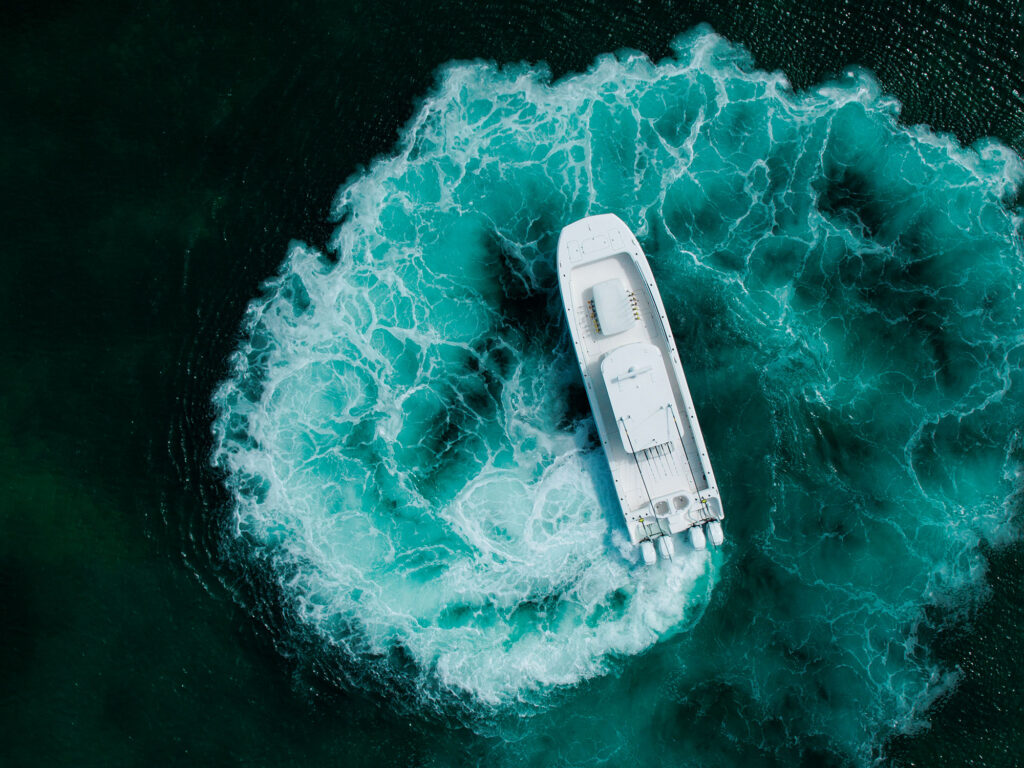
The popularity of the multihull (aka catamaran or cat) fishing boats has never been greater, as more and more boatbuilders enter this growing segment of the market. The inherent stability of the catamaran design rolls less with the seas, making fishing offshore less tiresome and more comfortable. Available from 20 to 48 feet, catamarans typically offer a large fishing platform with generous storage and fishing amenities. They are available in a wide variety of deck layouts, including center-consoles, dual-consoles, and even pilothouse and express variants.
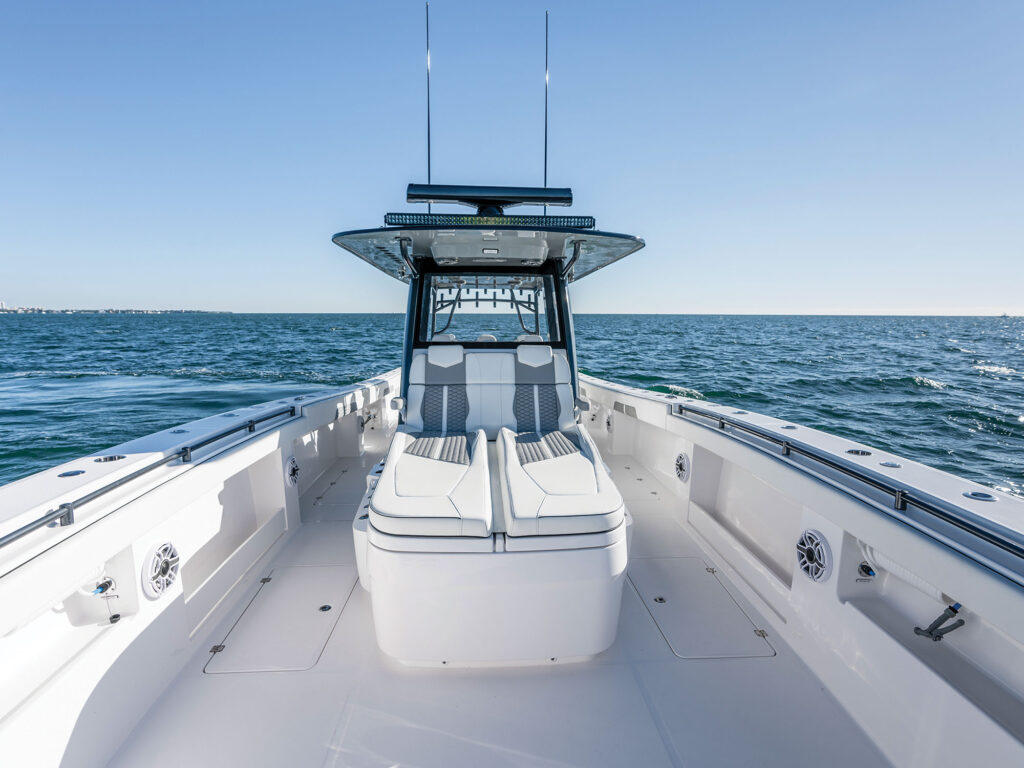
Big Picture
The large deck area of a catamaran enables many large underdeck storage lockers and insulated fish boxes in the sponsons. This gives anglers ample room for gear and the day’s catch. The catamaran’s stability, fishability, and smooth ride in rough seas make it attractive to anglers as well as day-cruisers. A center-console version adds 360 degrees of angler access to the rail. With the dual-console design, generous seating behind a beam-to-beam windshield makes for a great family fishing-friendly setup.
Live bait is one of the most popular types of fishing in virtually every coastal zone. To do it successfully requires optimal water capacity and proper flow. The minimum size of the outflow water plumbing should be twice the size of the inflow. The plumbing should have a drain at the bottom to shed scales at the end of the day, as well as a drain at the top of the well to adjust capacity and allow overflow. Above-deck transom-mounted wells should fully flood to the lids when running to keep baits from getting beat up.
Tip: A sump box with multiple pumps in case a pump fails is the best setup for first-rate livewells. Conveniently located inflow and outflow valves make it easy to optimize the flow without tiring your bait from swimming too much in the well.
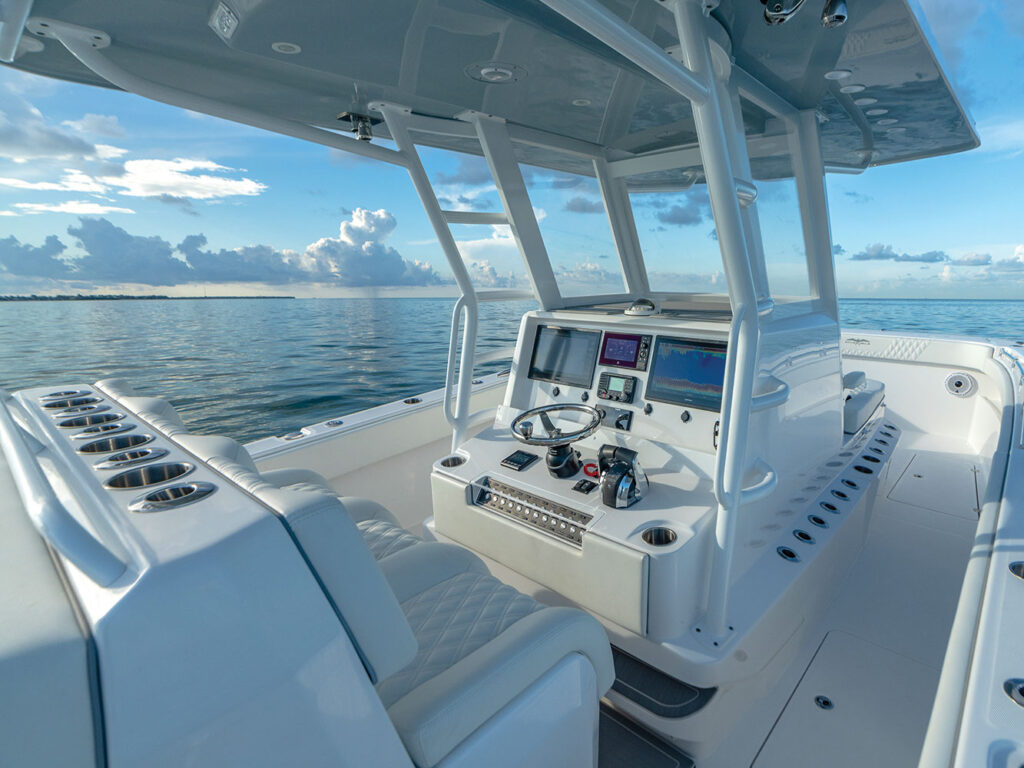
Rod Storage
Having enough rod holders is essential to be successful for opportunity fishing. Look for vertical rod storage along the console and across the back of the T-top. Many models also have rod holders along the outboard transom wall. Having plenty of gunwale rod holders for drift- and kite-fishing is helpful.
Tip: Placing adjustable swivel rod holders by Gemlux makes deep-dropping, lure-fishing and drifting even easier because they allow your rods to face the direction the baits are fishing, yet they can be swiveled back to keep rods from sticking out of the boat while running and docking.
Manufacturers often offer multiple choices for horsepower, but whatever the choice, the engines must come in pairs. For example, you might order twin outboards (one for each sponson) or four outboards (two for each sponson), but single- or triple-outboard configurations are not common on a cat. Optimal selection should be made based on user load, weight of the boat, ride comfort , performance desires, and best case for resale. It’s a rare day when you can run wide open, but having more horsepower gives better torque at slower speeds and thus better control. Running larger engines slower gives better fuel efficiency too.
Tip: When possible, choose the highest horsepower offered because it typically leads to a better resale value with a shorter sales cycle.
Power steering from engine manufacturer Optimus or SeaStar is essential with the higher horsepower required for larger boats, and it makes installing and operating the upper station in a tower far more practical and comfortable.
With the power demands of electronics, livewell pumps, stereo amps and more, it is wise to have at least two house batteries, and for larger boats, a third or fourth with a multibank charger for dockside. Each engine should have its own dedicated battery as well.
Electronics
Typically choosing the largest screen or multiple screens that will fit on the console is best-case scenario for ease of use, ergonomics, and visibility. VHF radios, stereo controller, and equipment switches for lighting, pumps, and accessories should all be integrated with greatest visibility and ease of operator reach.
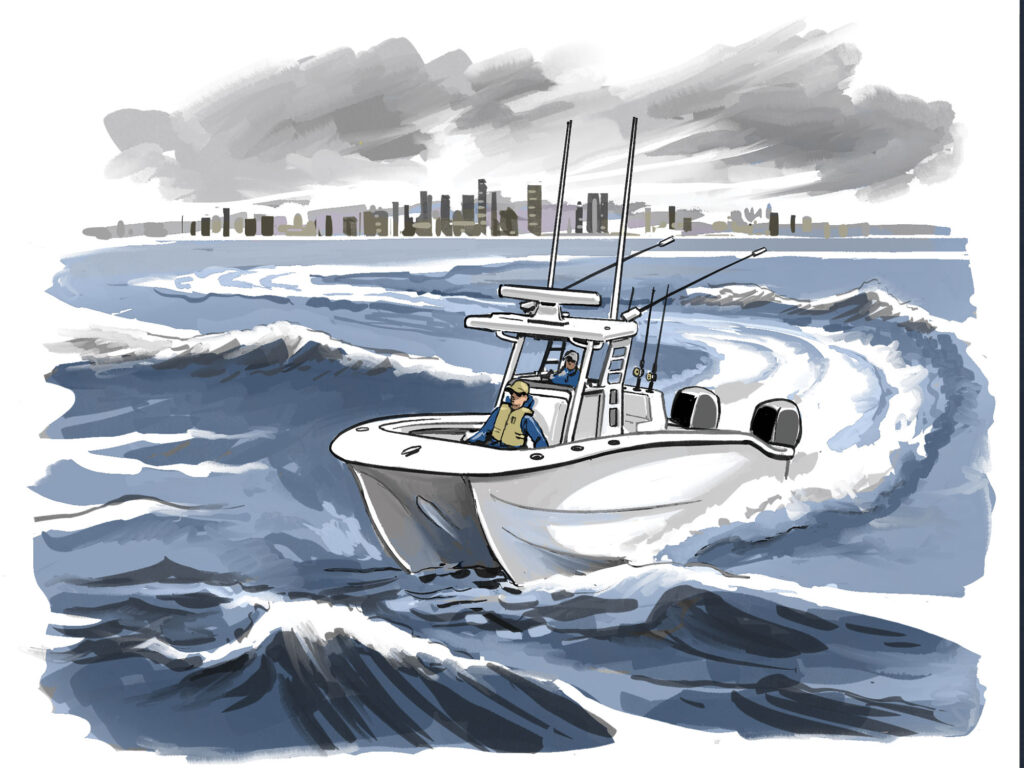
A Tale of Two Hulls
A catamaran rides on pair of hulls, or sponsons, each thinner and sharper than that of a similarly sized monohull boat. The narrow sponsons of the cat tend to slice easily through water to deliver a smooth ride, even in rough seas. At the same time, with the sponsons positioned out to the sides of the boat, cats tend to roll less, thus providing great stability to enhance crew comfort, security and safety. However, cats tend to corner more flatly than a monohull, and some hulls (but not all) tend to lean outward versus inward during a turn.
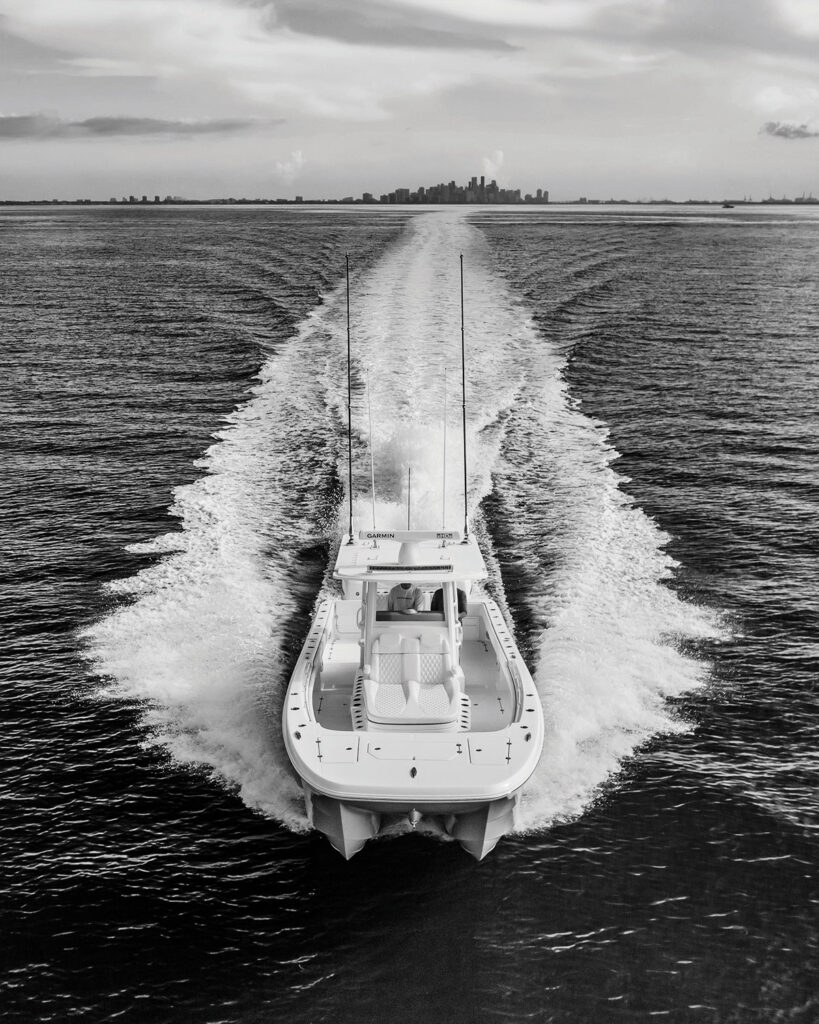
Experts Say
Newer designs such as Invincible’s Morelli and Melvin-designed semi-asymmetrical sponsons eliminate some of the negatives of the cat design, such as “sneezing,” where water sprays out the front of the boat when hitting a wave. They’ve also controlled the uncomfortable “outboard lean” sensation common in older designs when in a turn. Once transitioned to a catamaran, many become true believers and preach the benefits of the design.
Editor Says: Saltwater fishing cats not only offer superb stability and smooth ride, but some also display exceptional speed and range. I recall one trip out of Key West, Florida, aboard an Invincible 40 Cat with four 350 hp outboards to the Dry Tortugas. It was a 60-mile run, and we made it there in 70 minutes. We caught more fish than our arms could bear, and then dashed back to Key West, arriving in time for cocktail hour on the same day. -Jim Hendricks, Staff Editor, Boating and Fishing Group
- More: 2023 Boat Buyers Guide: More Resources , Boats
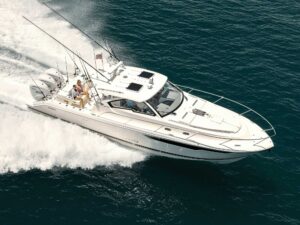
Pursuit OS 405 Offshore
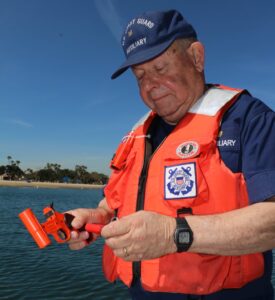
Prepare for Launch: The Springtime Vessel Safety Checklist
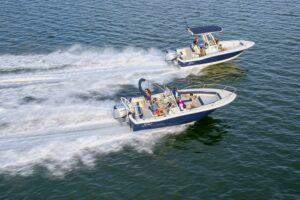
Honda Outboards and Scout Boats Create New Boat Line
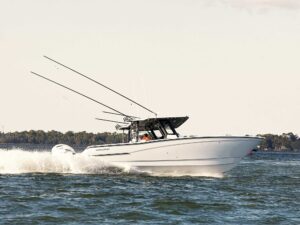
World Cat 400CC-X
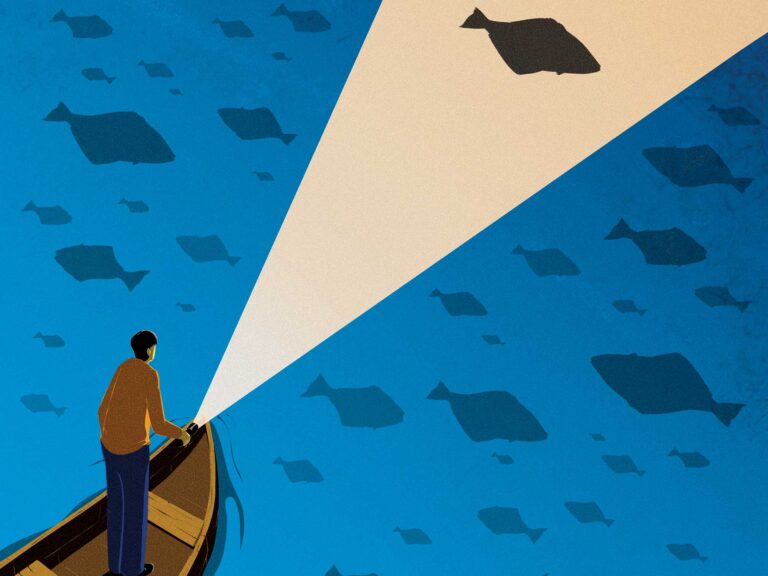
Where’s the Data for Making Changes to California’s Halibut Regulations?
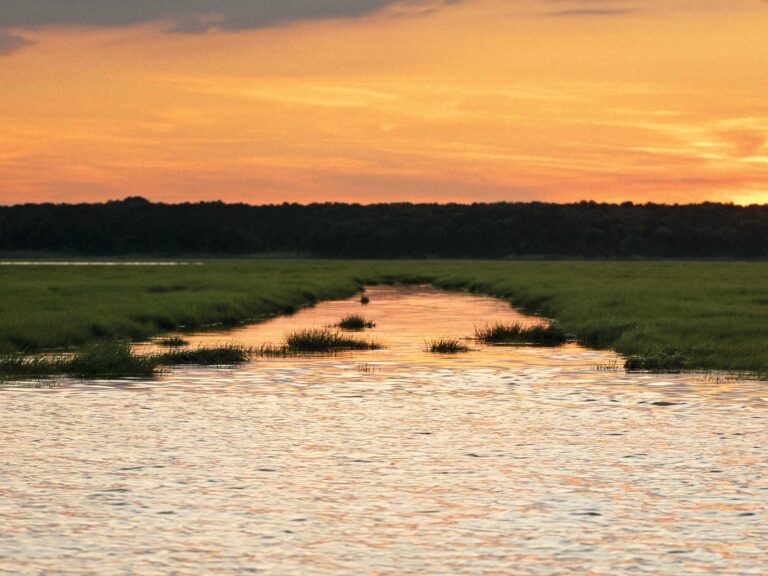
Chasing Striped Bass Through New Jersey Marshes
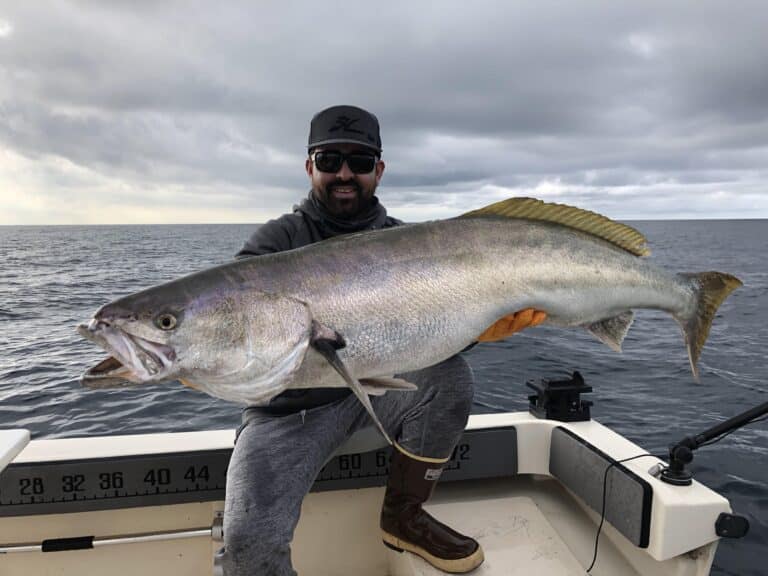
Where to Find the Best Fishing in March
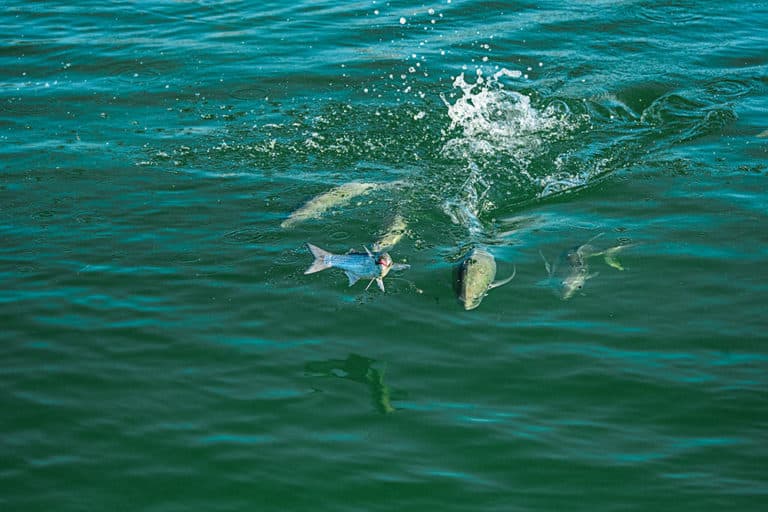
Kick Off Spring With the Southeast Mullet Run

- Digital Edition
- Customer Service
- Privacy Policy
- Cruising World
- Sailing World
- Salt Water Sportsman
- Sport Fishing
- Wakeboarding
- Articles and Guides
Best Catamaran Fishing Boat Brands
20th oct 2023 by lenny rudow.

Choosing the best catamaran fishing boats is no easy task, because in this day and age, you have plenty to choose from. This wasn’t always the case, but in recent years more and more power catamaran fishing boats have been hitting the market. The reasons are simple: Whether you’re looking at an offshore fishing catamaran, inshore catamaran fishing boats, or small catamaran fishing boats, foot-for-foot they tend to run smoother and more efficiently than their monohull brethren. While all the types of fishing boats are different and each has its own advantages and drawbacks, as a general rule, if you want to get to the fish fast in rough seas, nothing is better than a powercat for the job.
It’s tough to try to sort through various builders and nail down the best fishing boat brands , and the increase in the number of catamaran fishing boat manufacturers means choosing the top picks in this genre is as tough as any other. So, which brands are best? Here are our top picks in some of the most important categories and why we think they make the grade.
Best Catamaran Center Console Boat Brands
This will be a very short section, because virtually all of the catamaran sport fishing boats being built today are center consoles. Yes, some manufacturers offer pilothouse models or cuddy cabins, but those that don’t offer a lineup consisting mostly of center consoles are few and far between. So, keep on reading—the manufacturers we call out as tops for the more specific categories below all fall into the category of best catamaran center console boat brands, as well.
Best Offshore Fishing Catamaran Brands
Offshore boats need to meet some prerequisites: they have to be large and competent enough to run dozens of miles from shore, have the fuel capacity for cruising hours on end, and of course they need all the fishing accouterments to handle big game pelagics like tunas and billfish.
In many ways, Freeman is partially responsible for the current wave of cat popularity, because their 34- to 47-foot fleet was quickly adopted by a number of offshore fishing guides after they splashed their first model in 2007. Their boats are known for hat-stripping performance, often cruising comfortably at 50 mph or more, even in a head sea, with top-end speeds sometimes exceeding 70 mph. Tremendous fuel capacity and utterly massive fishboxes are some other traits the Freemans are famous for.

Invincible Boats offers a lineup including both monohulls and power catamarans, with center console cats ranging from 33 to 46 feet plus a 46-foot pilothouse model. These boats post spectacular speeds with cruising in the 50 mph range and often they can break 70 mph at top-end, thanks to semi-asymmetrical hulls with near-vertical inside walls. Invincible is also known for its advanced and customizable livewell systems. On the 46, for example, the boat can be rigged with up to four livewells up to 70 gallons each, fed by a sea chest system with as many as six pumps.

When judged by the number of hulls built, World Cat is one of the biggest powercat manufacturers in existence, and the company has a lineup that starts small but includes five models from 26 to 40 feet that are up to the task of offshore fishing. They have all the basic fishing features, plenty of range, and comparatively good performance, but what they’re known for when matched up against the competition is a healthy dose of family-friendly features. Unlike some angling-dedicated offshore fishing catamaran models, the World Cats feature lots of comfy seating, roomy head console compartments, freshwater showers, stereo systems, and similar touches that can take the edge off a long day of fishing.

Best Inshore Fishing Catamaran Boat Brands
Inshore anglers can be just as demanding as the offshore crowd, and when the weather is right many of them will head into the open ocean as well. So, the main defining factor separating offshore fishing catamaran boats from inshore catamaran fishing boats is simply size. And often, the line between the two gets blurred. As a result, you’ll see some newcomers here, but some of the best catamaran fishing boat brands we’ve already talked about could easily pull a repeat performance.
Caymas is a newcomer to the catamaran world, having built only monohulls up to the 2023 model year. Their new 34, however, is an impressive boat which has offshore abilities and will also make an excellent inshore fishing machine. It rides on a set of twin-stepped hulls with 18/22-degree deadrise surfaces at the transom and 50/55-degree entries at the bow, features a Hooker sea chest livewell system with 70 gallons standard and an additional 50 gallons optional, and plenty of high-end perks like lighted stowage compartments, a JL Marine audio system, and USB ports at the helm.

Photo credit: Caymas Boats
Tideline is a small, semi-custom builder in North Carolina, and their boats can be difficult to find on the market, but we need to mention them here because they build a 24-footer that’s well known as one of the finest inshore hybrid fishing cats around. With twin 200-hp outboards, it boasts 50-plus-mph performance, has an utterly massive forward casting deck for slinging lures to gamefish like reds and specks, and hull draft is a mere 14 inches so it can sneak into the shallows where few anglers tread.

Photo credit: Tideline Boats
Twin Vee does make some large models intended for offshore use but their 24- to 28-foot center console models are perfect for inshore angling. Better yet for many family fishermen who want a multipurpose platform, they also offer a pair of dual console 24-foot models. Twin Vees have a “compression tunnel” that packs air between the two hulls and compresses it as the boat moves forward, creating a cushion of sorts that makes for an unusually soft ride in choppy seas.
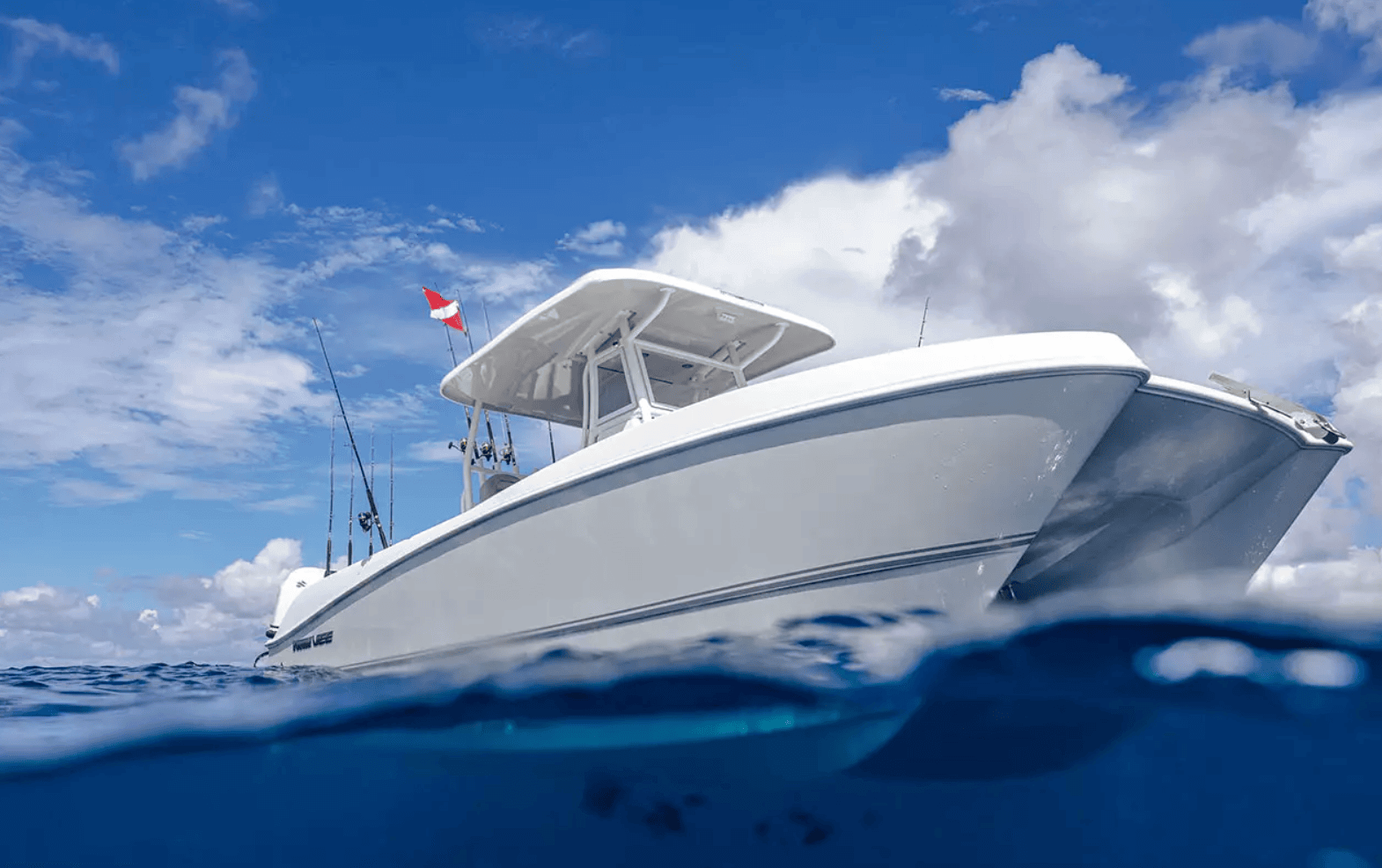
Photo credit: Twin Vee
World Cat is back as we discuss the inshore scene, thanks to models like their 235CC and 260 and 280CC-X. The 235CC is designed like a bay boat, with large fore and aft casting decks, while the 260CC-X features a very unusual drop-down transom design, with the livewell and fishbox shifted into widened aft gunwales. Like other World Cats, these boats have plenty of comfort features to go along with the angling perks.

Photo credit: World Cat
Best Small Catamaran Fishing Boat Brands
“Small” is a relative term, and while 20- to 24-footers may seem like small catamaran fishing boats to some folks, they seem mighty big to others. However, the distinction is more or less moot because in the current marketplace, no major production builders drop down below 22 feet, seven inches of LOA (the World Cat 235CC). If you want a cat under this size, you can look for a custom builder or search the used boat market. Twin Vee made plenty of 19- to 22-foot boats in years past, Tideline made a 19, and when they were in operation, catamaran boat brands like Leader and Nautico made a number of powercats between 14 and 21 feet.
Choosing the Best Catamaran Brand For You
Are there some powercat brands out there that build a great boat, but we haven’t mentioned? Absolutely. Arrow Cat builds a pair of interesting cabin boats that aren’t 100-percent fishing machines, but do have semi-fishy cockpits that would work just fine for plenty of people. C Dory makes a 25-footer that falls into the same category. And Aquila , which traditionally built large cruising boats, has recently introduced a 28-foot center console billed as a fishing boat. Any of these, or others, could be the “best” brand for you, depending on your personal needs and tastes. But the power catamaran fishing boat manufacturers we’ve called out here are all arguably at the top of the heap—nd if you take one for a sea trial, we’re betting you’ll agree.
Written By: Lenny Rudow
With over three decades of experience in marine journalism, Lenny Rudow has contributed to dozens of boating and fishing publications and websites. Rudow lives in Annapolis, Maryland, and is currently Angler in Chief at Rudow’s FishTalk ; he is a past president of Boating Writers International (BWI), a graduate of the Westlawn School of Yacht Design, and has won numerous BWI and OWAA writing awards.
More from: Lenny Rudow
Related Articles and Guides
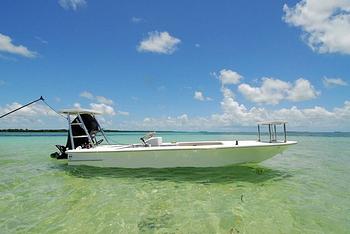
4th Mar 2024
The Best Flats Boats Brands, Special Boats for Skinny Waters
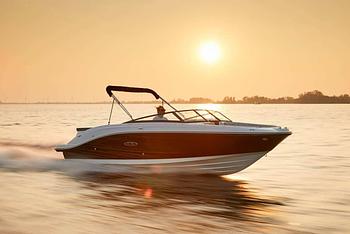
21st Feb 2024
Best Lake Boat Brands for Fishing, Cruising, and Watersports

15th Feb 2024
Best Aluminum Fishing Boat Brands: Tougher, Lighter and More Affordable
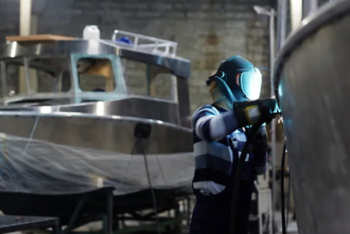
2nd Feb 2024
Aluminum vs Fiberglass Boats: Which is Best and Why?
- Explore Rightboat
- Boats for Sale
- Boating Articles
- Buyers Guide
- About RightBoat
- Sell Your Boat
- Boat Selling Advice
Enter your email to keep up to date with the latest news
Join for free
Sign up now for free and discover how easy it is to keep up to date with THE latest boats for sale. Find your right boat, and tailor your voyage to finding your next boat.
Benefits of becoming a member:
- Set up tailored alerts
- Personalise your experience
- Download full specifications and broker details
- Keep tabs on your favourite boats
Are you a broker? Join as a Broker
Rightboat - join for free.
Do you have an account already? Login
Save this search
Save your search and receive new boats in your email..
You can unsubscribe from your alerts whenever you like. By pressing the button you accept the Legal Terms and conditions
- News & Events

Handcrafted. Custom. Catamarans.
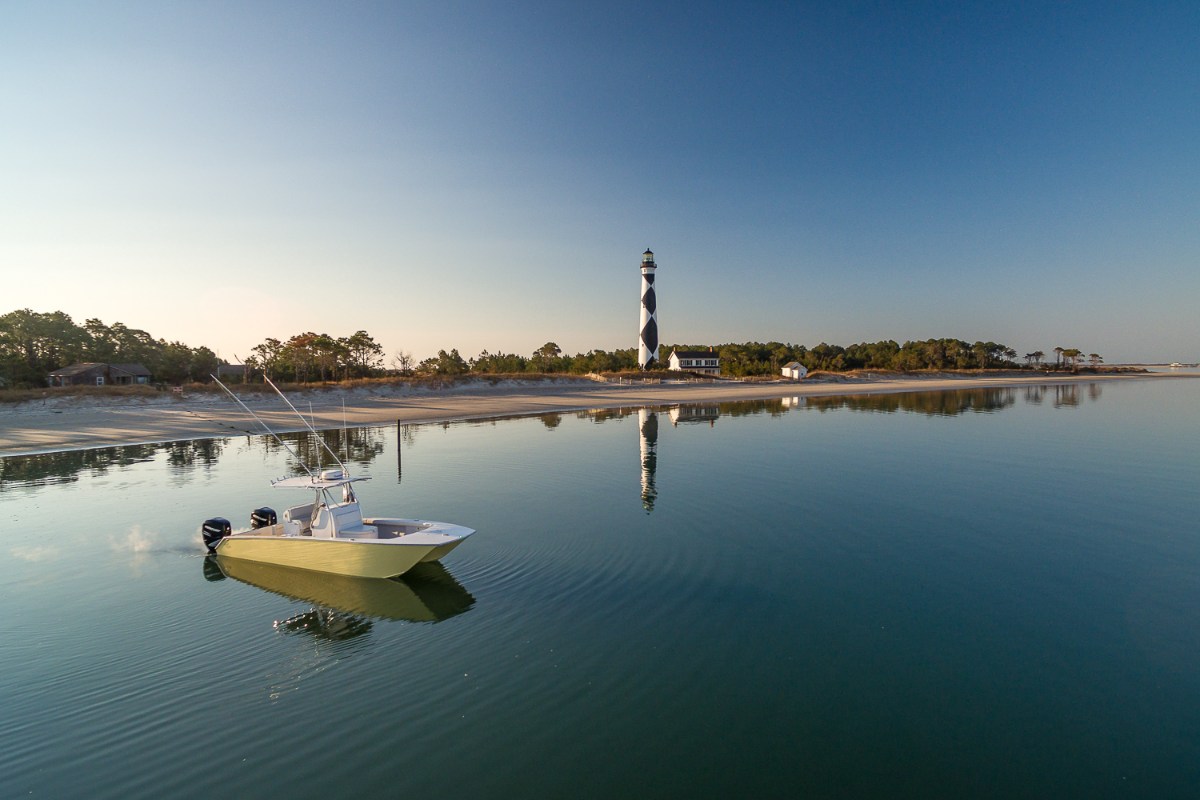
Island Hopper
NEW MODEL - The perfect family boat is here. Doesn’t matter if you like pulling up to sandbar parties, cruising around a lake, or nosing up on an island, the Island Hopper will provide everyone with a fun time on the water.
NEW MODEL - This shallow draft Bay Boat will get you everywhere you want to go. With an in-class leading amount of deck space, there is more than enough room to carry duck decoys, beach bags, and comfortably enjoy the water with your whole crew.
22SF Catamaran
A popular model throughout the Southeast, these smooth-riding catamarans are equally capable of taking the family for a joy ride or cutting through some chop in the ICW.
25SF Catamaran
Available with single or twin motors, the 25SF can make getting offshore a breeze. A spacious boat that is easy to maneuver and capable of going anywhere on the water.
29SF Catamaran
This catamaran can be customized for any boater. If you prefer a sunset cruise in the river, or you want to spend all day bringing in Wahoo, this cat can be customized for whatever you desire.
32SF Catamaran
Used by fishermen and fire departments in the Southeast, our 32’ catamaran gives you plenty of space for all your charter guests.
35SF Catamaran
Our largest boat gives you the size and range for any type of fishing, anywhere you want to go. Customize this with an upper station and a huge coffin box.
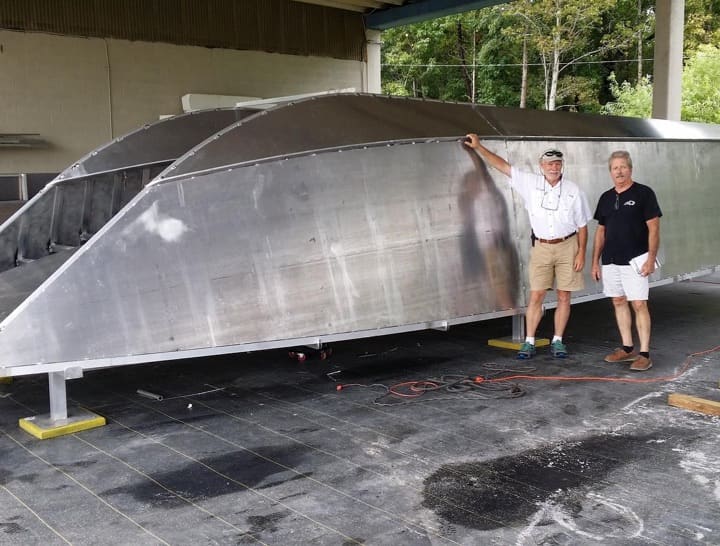
Aluminum Hulls
At twice the strength of fiberglass, our lifetime guaranteed aluminum hulls will provide you with a supremely maneuverable boat that can travel faster and with less draft, all while providing a safe boating experience.
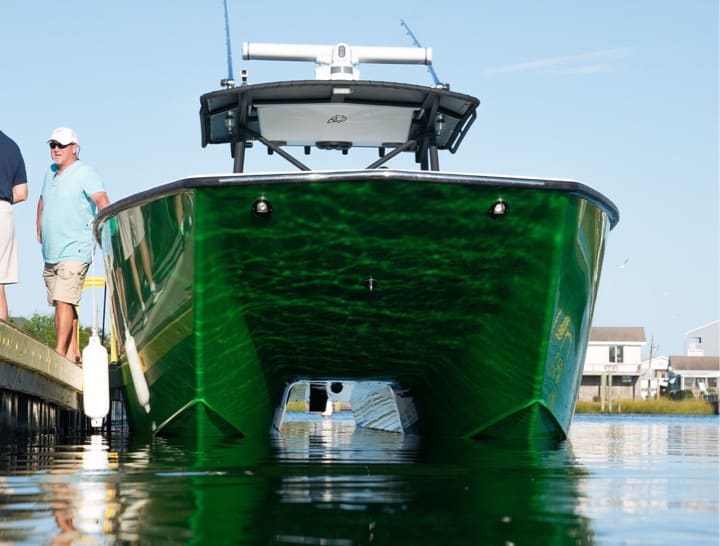
Catamaran Design
Catamaran hulls provide a softer, more stable ride with exceptional efficiency all while providing optimal deck space due to wider beams. The lower center of gravity will give you a ride with the least impact.
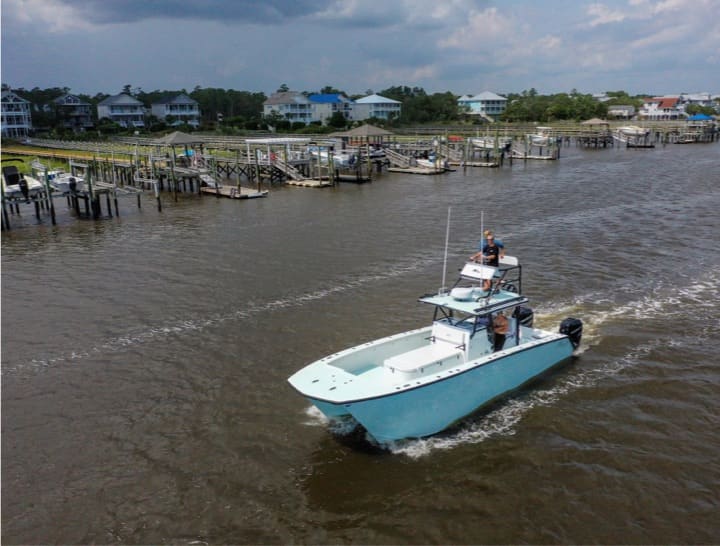
2 Decades of Experience
A track record of over two decades of building custom aluminum boats ensures that you will be getting the boat you deserve. Boats built by artisans dedicated to delivering the perfect vessel for you.
Built by Artisans
The Cape Fear Cats team of artisans is invested in seeing your boat all the way through from design to delivery. Our in-house welders, fabricators, riggers, and painters are able to build your boat 100% on site.
We craft all of our 100% aluminum boats to your specific design. Our commercial strength hulls will provide you a top of the line boating and fishing experience.
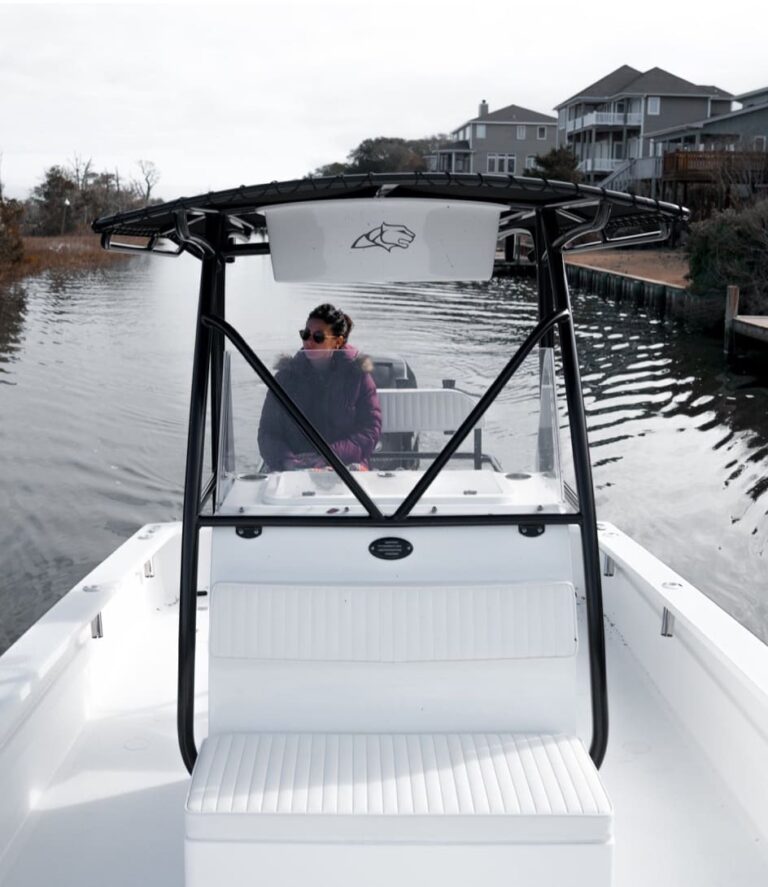

Matt Weidert
BVI Fishing Tips: Here’s Where to Find the Fish
Who is this bvi fishing guide for.
- BVI fishing license & registration
- Fishing regulations
- BVI fishing techniques
Where to fish in the British Virgin Islands?
.jpg)
BVI fishing license & registration
- Individuals (18+ or older) that intend to fish MUST each obtain a BVI fishing license
- The vessel you are going to fish from MUST be a BVI registered fishing vessel
How to obtain a BVI fishing license
- Fill out the BVI Form 20a (application)
- Fill out the credit card authorization
- Obtain a copy of your identification - they recommend a scan of your passport
- Submit all three items to [email protected] for approval
- It costs $45/person (as of Sep-2023)
- It is also referred to as a Pleasure Fishing License or Fishing Permit
- Plan for at least a 2 week turnaround for approval - so don't wait until right before you leave for your trip
- The license will be good for 30 days - you get to choose the start date
- Here's the most current guidance from BVI
How to make sure you are sailing on a registered fishing vessel
- Charter with a company that registers all of their vessels for fishing
- Check with your charter company if the vessel you are booked on is registered. If it is, you are all set!
- Ask to be switched to a boat that is registered
- Switch to a different charter company
- Appeal to your charter company that you would be willing to pay the fee if they could handle filing the paperwork (around $100). Start this process early, weeks before your trip. Assume this will not be a priority for them
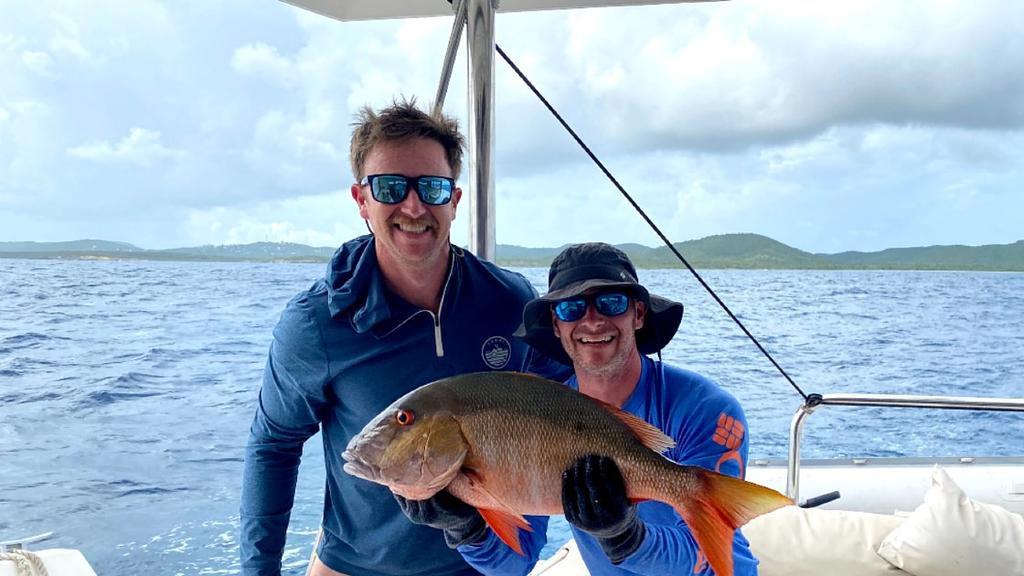
BVI fishing regulations
- Using a speargun is illegal at all times - stick to fishing rods
- Goliath grouper and turtles are off limits at all times
- There are no specific size limits (that I have been able to find)
- Conch, whelk, and lobster may not be taken at all by visitors
BVI fishing techniques
Bvi diving lures, bvi surface lures.
.jpg)
- On your way to Anegada, instead of a straight shot, head NE from Virgin Gorda and around Horseshoe Reef to the drop. Continue counter clockwise around Anegada trolling the drop. This will be a longer day on the water, so get an early start (~50 nautical miles). This is best done in settled weather.
- Head straight to Anegada and spend two nights at Setting Point. On your second day, leave the anchorage for some North Drop fishing in the morning. Return back to Setting Point in the afternoon.
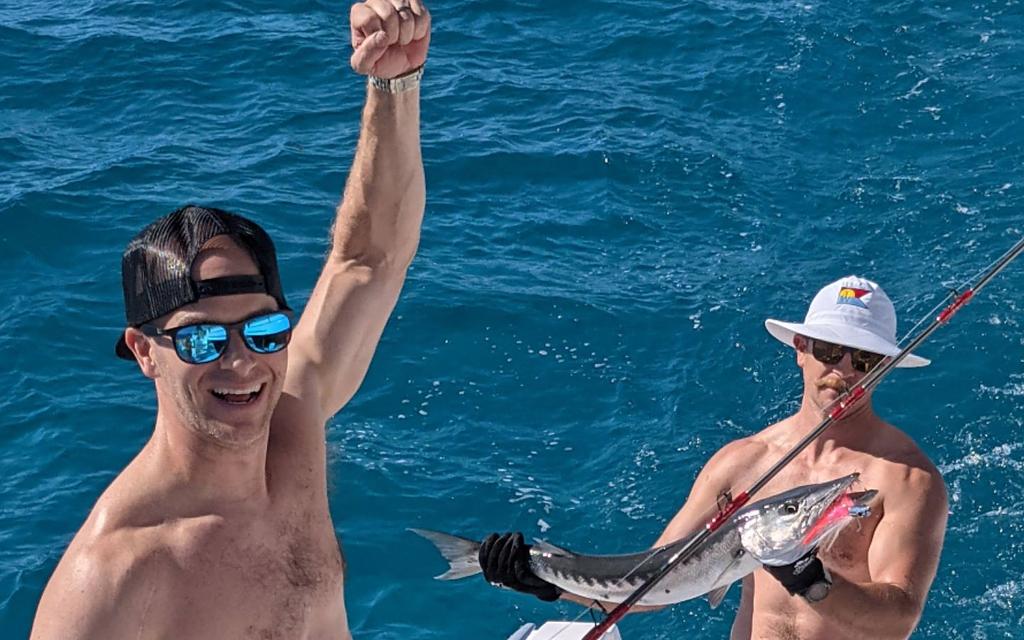
Shelf or inshore fishing areas
North of tortola, including between anegada and jost van dyke, south of norman and peter islands, sir francis drake channel, explore these related articles from the yacht warriors.
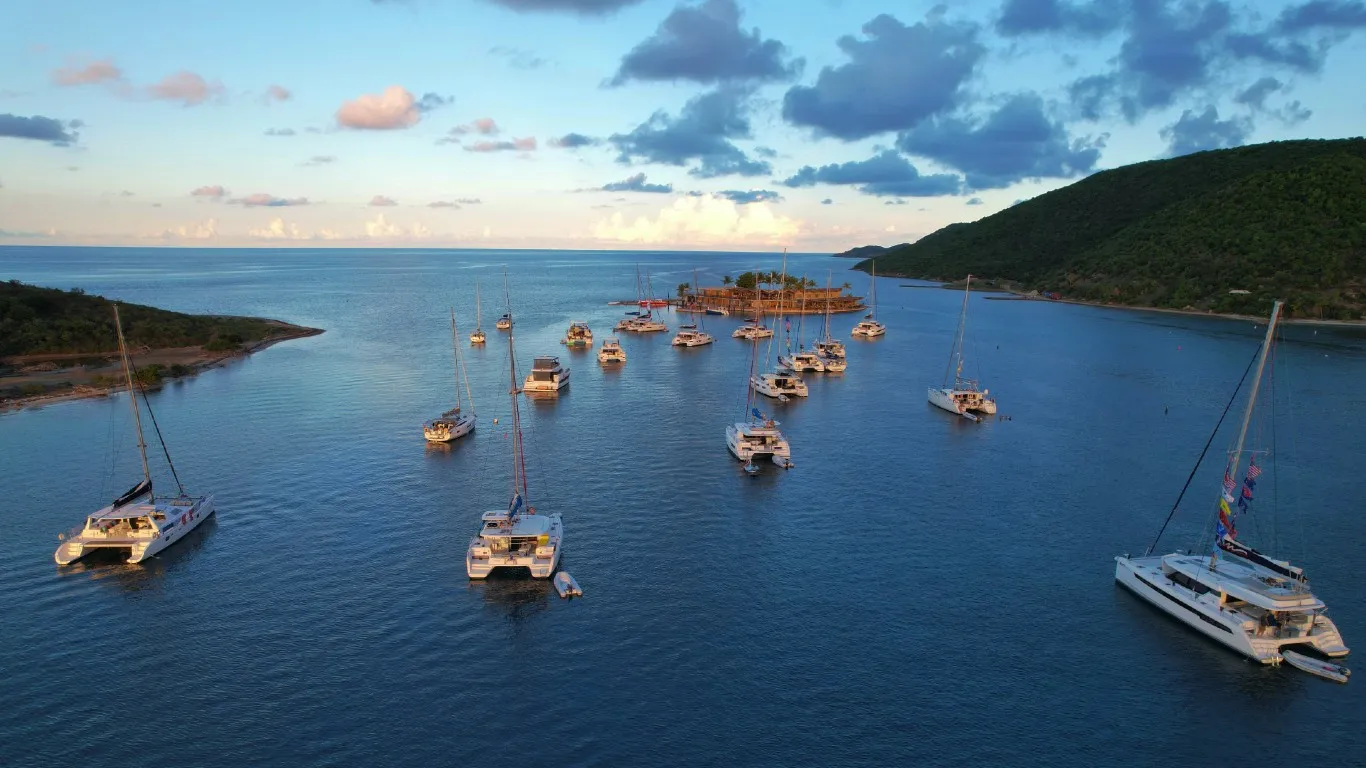
The complete sailing trip packing list- Here’s What to Pack
We've perfected our sailing trip packing list over the years. Here's what to pack on your next trip - the obvious, and maybe not so-obvious.
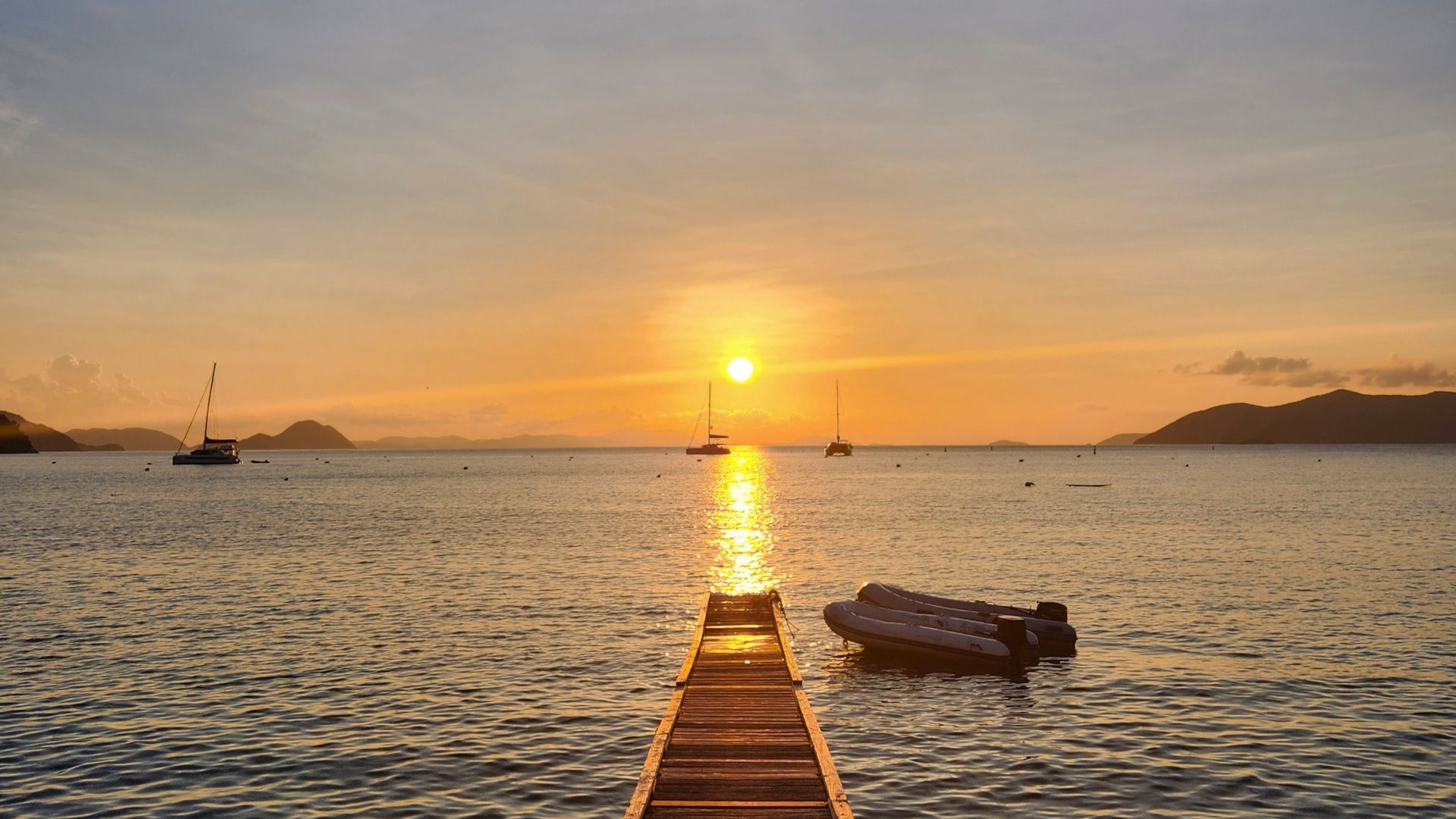
2024 BVI Charter Season Preview
Find out what's new for the 2024 BVI charter season including new catamaran additions and the latest need-to-know charter developments.
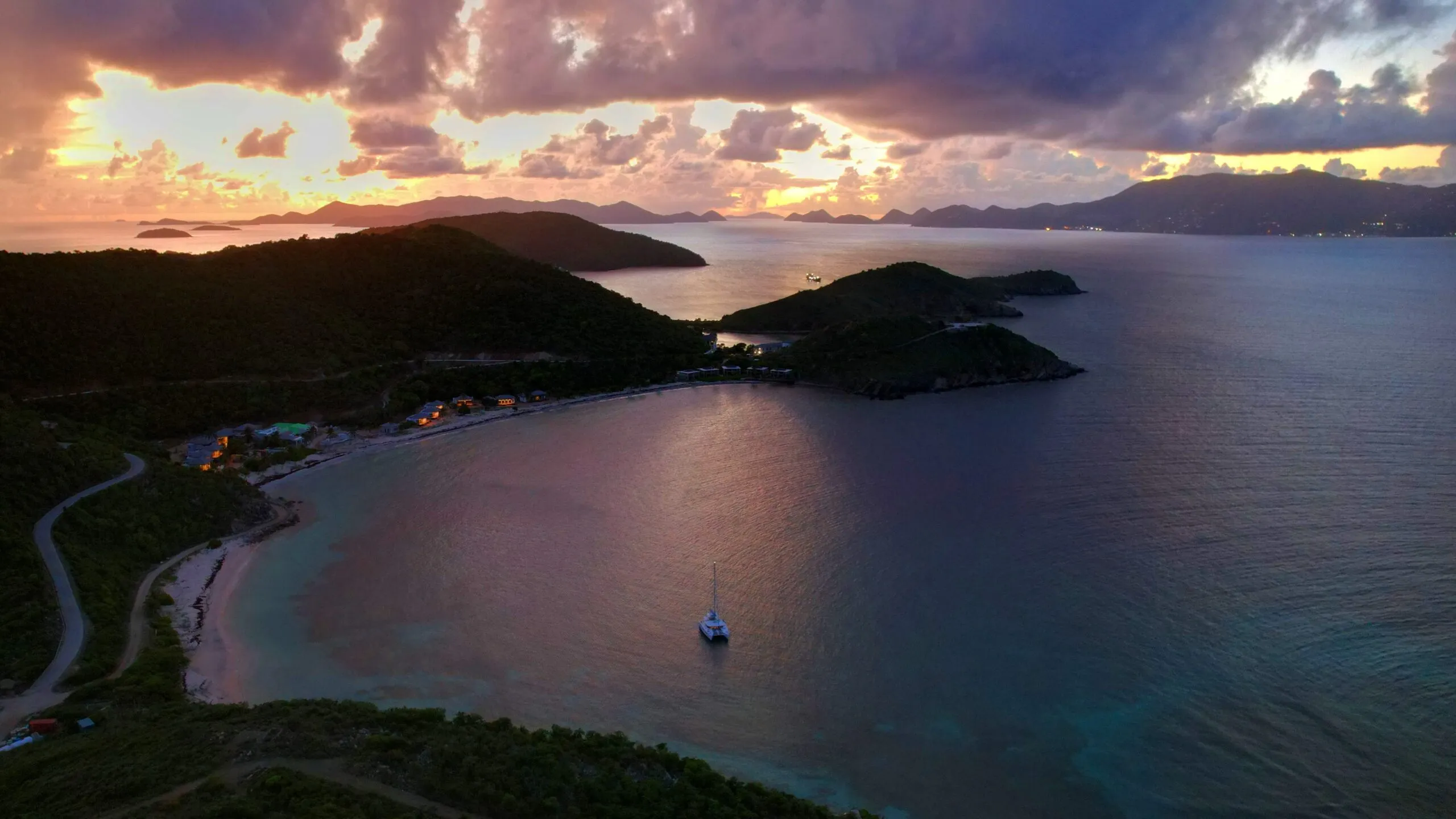
BVI Sailing Itinerary: The Perfect Week in the BVI
There is no better place for a sailing trip than the British Virgin Islands. Check out my perfect week-long BVI sailing itinerary.
When is your next yacht charter? Consider booking with the Yacht Warriors.
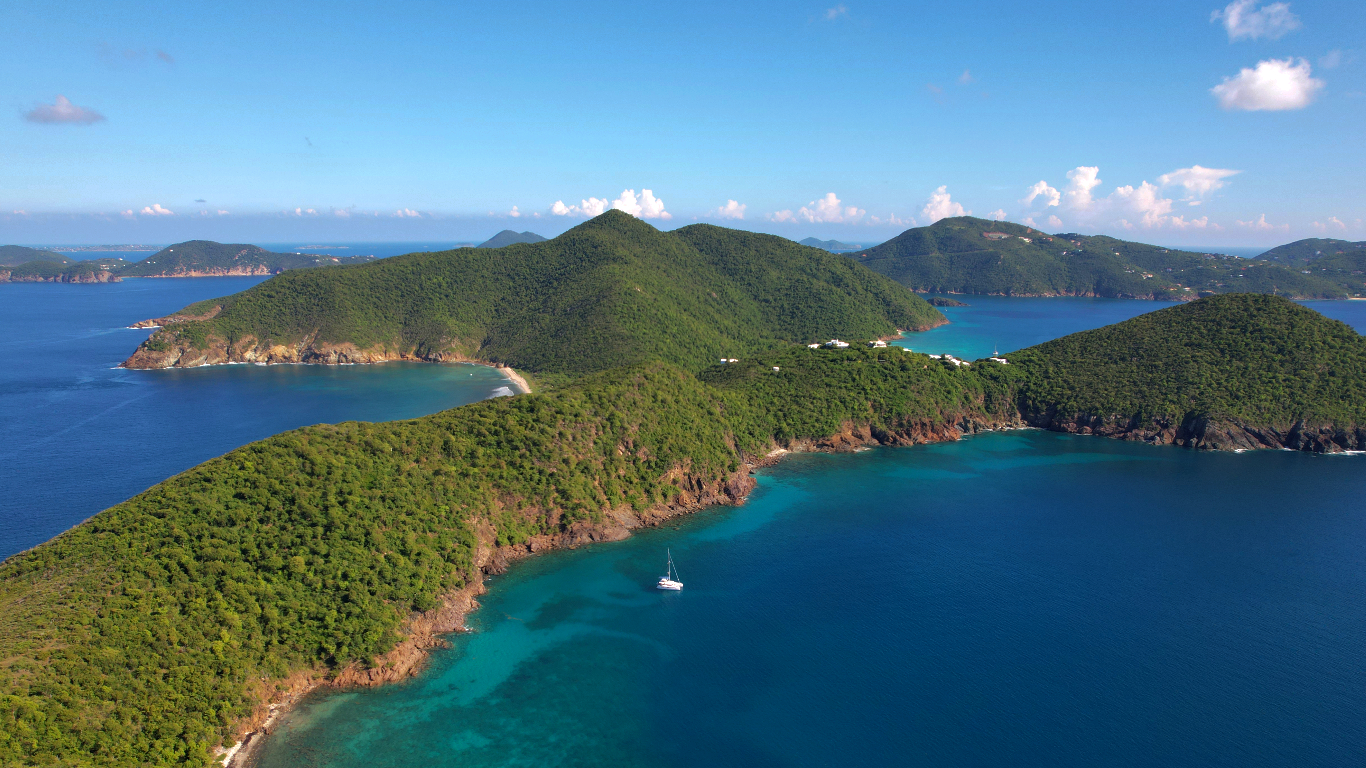
Charter. Beyond.
Get fresh ideas for your next yacht charter trip - insider guides, sailing itineraries, planning tips, and more. Subscribe and receive my free BVI Trip Planning Document.

How To Sail a Catamaran Upwind or Downwind (Complete Guide)
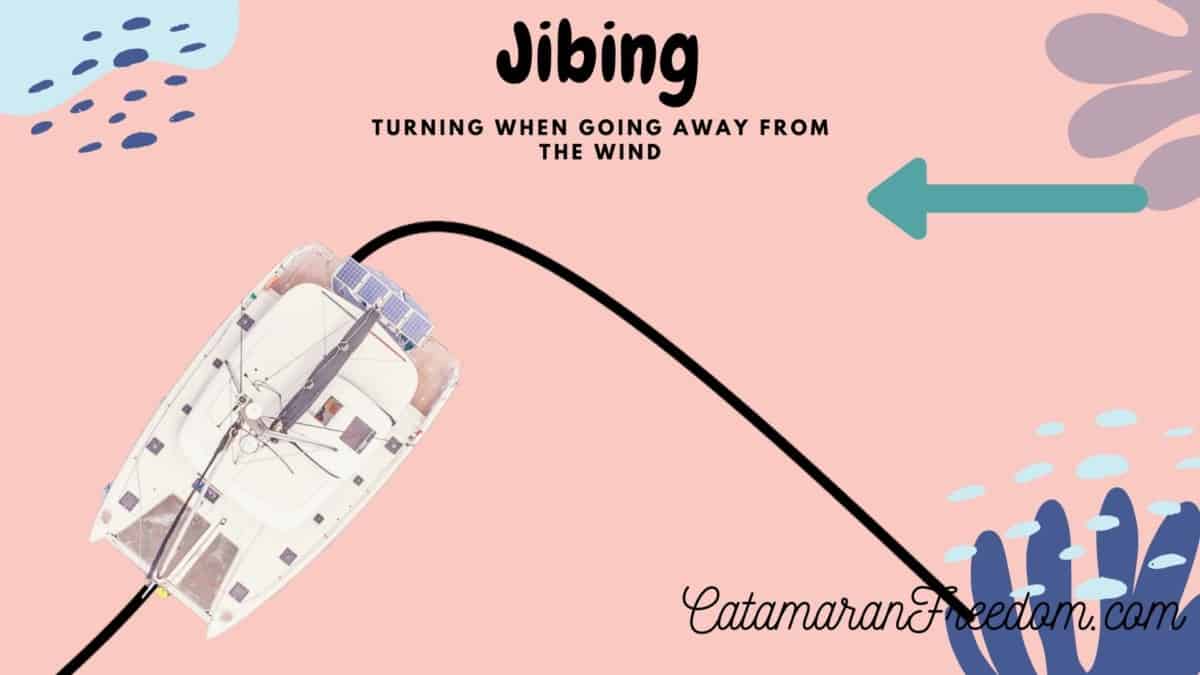
As an Amazon Associate, we earn from qualifying purchases. We may also earn commissions if you purchase products from other retailers after clicking on a link from our site.
Catamarans are the perfect backdrop to a relaxing fishing excursion, with sails in the wind as you reel in 50-pound striped bass. But when the gusts pick up and shift directions, you’ll find yourself weathering uncharted territory where reefing and speed are unlike a classic monohull. Sailing a catamaran upwind and downwind requires a skill set much different from the classic one hulled sailing.
To sail a catamaran upwind, maintain high speeds, center the mainsheet, limit angles to 45-60°, lose unnecessary weight, upgrade to Kevlar sails and daggerboards. To sail a catamaran downwind, maintain 160-170°, use asymmetrical spinnakers, reef when winds exceed 15 knots, and jibe.
Downwind gusts can help a catamaran surf down waves, something that is extremely exciting. However, facing those dreaded upwind breezes (especially without daggerboards) can signal the end of a soothing Mediterranian adventure. To learn how to sail a catamaran upwind or downwind, read on!
Table of Contents
How Sailing a Catamaran Is Different Than Monohulls
Multihull vessels like catamarans respond very differently to rough surfs, gusting winds, and shallow waters. If you’re still questioning, “What’s the difference?” here’s your answer.
Compared to classic monohull boats, catamarans are:
- More stable — at sail and when anchored — and less likely to heel or rock from side to side.
- Less responsive to waves and winds (detecting these requires keen observation skills).
- Likely to struggle when sailing into the wind.
- Harder to tack (high speeds are essential to avoid losing momentum)
Traditional yacht enthusiasts quickly learn that sailing a catamaran is smoother, though stiff headwinds and choppy surf are more challenging to overcome. Learning to master upwind and downwind catamaran sailing is essential to get the most out of your trip
If there’s one debate looming over the sailing community, it’s the age-old catamaran versus monohull discussion.
What is the difference b e tween cats and monos?
The UPWIND Catamaran Sailing Guide
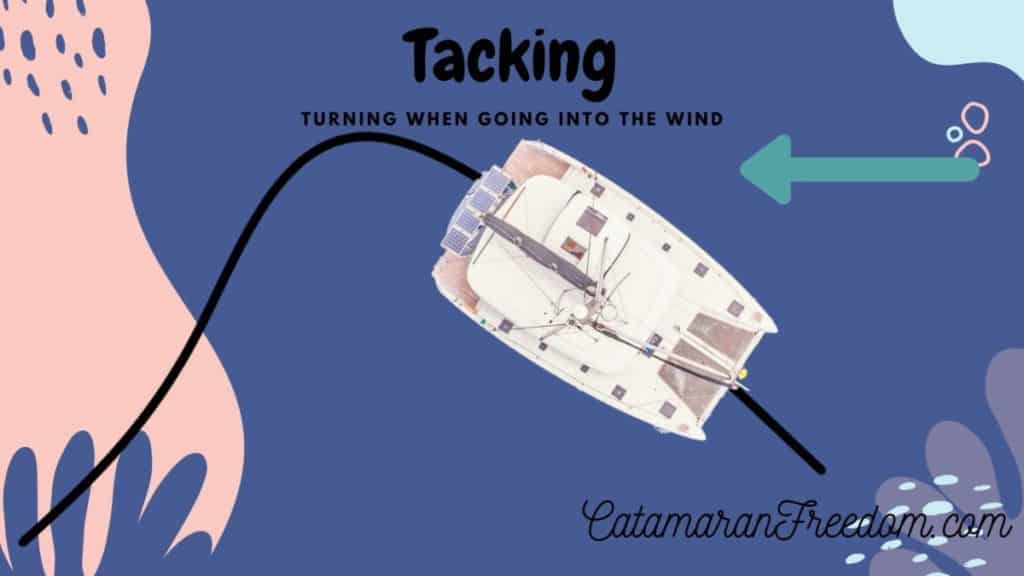
Sailing upwind means you’re cruising your catamaran toward the wind (i.e., Traveling east against westward-blowing gusts). This added wind resistance makes it more challenging to reach your destination swiftly and safely, as upwind journeys could come with:
- Relentless sail luffing (fluttering like a bedsheet on a clothesline)
- Slowed speeds and VMG (velocity made good)
- Deep-digging bows in waves
- Bridge deck slamming
Preparing for an upwind journey means taking the path of least resistance and the “long way home.” To survive your next upwind sail unscathed, follow these tips:
Maintain High Speeds
Thirty-knot gusts at-sea, high speeds, and a Leopard 44 might sound like a recipe for disaster. But a catamaran’s multihull design allows for lower capsize risks and less heeling in rougher conditions. It’s far gentler on the vessel to maintain momentum than to build throttle against heavy winds.
Sailing a catamaran upwind requires sail, chart plotter, and daggerboard monitoring. The video below discusses upwind sailing tips as your catamaran’s bow faces 20-knot gusts.
Limit Angles to 45–60°
A straight line is undoubtedly the shortest pathway to your on-shore destination, but sailing your catamaran directly into the wind will land you in the dreaded “no-go zone.” That is, sailing into 15-knot wind gusts directly, draining all forward momentum (unless motoring), and being unable to steer responsively.
The point of sail “sweet spot” for catamarans sailing upwind is between 45 and 60°. This tight range will keep the bow headed in the right direction — toward a particular cove or dock — without cutting throttle (too direct) or over-inflating the sails (too perpendicular).
An onboard flag can help you accurately detect your current point of sail (there are of course electronic aids as well). You should adjust the sails intentionally to ensure the perfect angle:
- Slowly let out your sail.
- Wait for the telltale to begin luffing (flapping in the wind).
- Gently tug it back until the telltale flapping stops.
Upgrade to Kevlar Sails
Catamarans are impressively resistant to heeling where dainty monohulls might capsize. But instead of “giving” with the wind, a catamaran’s classic polyester sails will resist 30+ knot gusts almost entirely. Even the highest-tenacity Dacron sailcloths will develop wear and tear, performance-reducing distortions, or irreversible breakage in heavy winds.
Investing in heavy-duty Kevlar sails can create stiffer and more damage-proof sails that can better handle upwind excursions. Upgraded catamaran sail cloths can help you travel a crisper pathway at a close-hauled 45° without overcompensating at the wheel.
Select a Daggerboard Catamaran
Daggerboards are retractable vertical keels attached to a catamaran’s underbelly. These large, below-deck protrusions can prevent or limit any leeway in exceptionally windy conditions.
Daggerboards vs Centerboards explained!
In other words, daggerboards will keep your catamaran from drifting with the wind or falling off course. The $30,000 higher price tag is undoubtedly off-putting, especially when proper tacking technique might render them useless. But the benefits are substantial:
- Sailing 1-2 knots faster than a standard keeled catamaran
- Traveling 5-7° closer to the no-go zone
- Reaching your upwind destination quicker and with less dramatic tacking
Catamarans with daggerboards installed are more reliable and accurate when traveling upwind. But these built-in keels require proper care to prevent grounding or lurching into a reef. Until your sea voyages bring you upwind, keep your daggerboards raised.
Clean Hulls
Aside from trimming the sails and staying in the close-hauled zone, there’s only so much you can do onboard to better tackle an upwind voyage. But what about beneath the water’s surface? A dirty underside can wreak havoc on your catamaran’s all-around performance — cutting RPM by 1,000, draining fuel efficiency, and slashing your maximum speed by several kts.
Keeping your catamaran hulls free of barnacles, grime, and fouling can make your upwind travels far less treacherous. Revive upwind sailing potential by:
- Spraying the bottom clean with an on-land hose
- Scrubbing the slimy waterline with a soft brush or sponge
- Dislodging caked-on algae with a plastic putty knife
- Applying a fresh coat of antifouling paint
Scrub your catamaran’s underbelly clean at least four times a year, though monthly is preferred for maximum performance. You’ll quickly notice a swifter, cleaner, and smoother journey the next time you take your catamaran up the coast.
Trim the Sails & Center the Mainsheet
“Trimming” the sails is a beginner’s catamaran cruising skill designed to improve speed and better catch the breeze. By changing the angle of the sails and adjusting line tension, you can evade sail luffing and add several knots to your voyage — especially upwind. It takes practice to adapt your sails to the wind speed and direction, so here are the catamaran sail trimming basics:
- Lock the mainsheet and position the boom so that it’s somewhat leeward (further away from the wind gusts).
- As you veer away from the wind, slightly ease the traveler and monitor the telltales.
- Start slowly easing the mainsheet when you’re on a beam or reaching (when the catamaran is at the right angle to the wind).
- Keep an eye on the telltales and watch for differences between leward and windward side (bluffing or flopping).
As you go through the classic trial and error process, don’t forget to keep the mainsheet centered — or as close to the center as possible. Otherwise, turning the winches in 18+ knot winds will require superhuman strength to get back on track, complicating your sail.
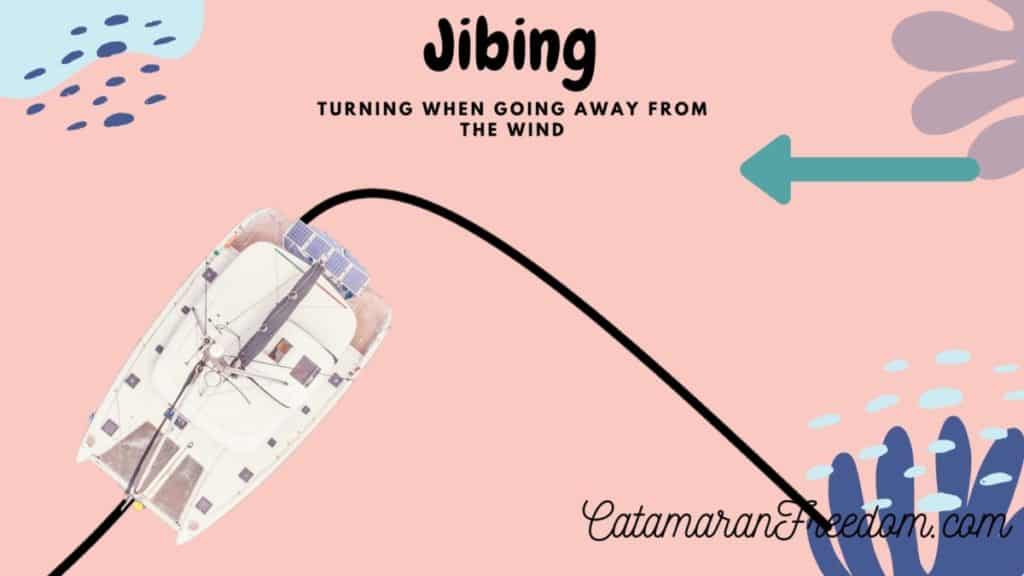
Steering clear of the no-go zone (straight into the wind) will keep your catamaran from stalling and your sails from flapping around and potentially increasing wear. But you’ll never arrive at your coordinates if you’re staying on a strict 45° path in one direction. This is where skilled catamaran sailors begin “tacking”, the art of turning your boat with the wind on your bows.
When you tack on a sailboat, you’re forcing the bows into the wind’s direction (no go zone). Tacking redirects the bow to the opposite 45° angle — from 3 o’clock to 9 o’clock — and creates a zig-zag formation or subtle 90° turns through the water. Proper tacking requires a skilled crew on larger catamarans but can be a solo pursuit. Here’s how to do this maneuver carefully:
- Start by sailing as close to the close-hauled territory as possible (within 40-45°).
- Choose a heading 90° away as your turn “destination.”
- Alert the crew to the tacking (if applicable).
- Slowly release the loaded jib sheet and begin pulling the lazy sheet inward.
- Steer the catamaran into the turn while maintaining speed (don’t speed up or slow down).
- Allow the sail to backfill to assist with the pivot.
- Release the jib sheet (watch your fingers, as the line releases quickly).
- Tighten the jib sheet on the opposite side and feel the wind start powering the boat.
Tacking is a challenging sailing concept to master. But it’s also the only way to sail upwind efficiently.
Turn On the Motor
A traditional, motor-free catamaran cruise can be soothing if there’s no destination in mind. However, the sails become inefficient against 15-knot winds when your preferred snorkeling spot is several miles directly into the wind. The best way to sail upwind is by turning to your catamaran’s twin diesel engines and hitting the throttle. Even cranking the engine to half-speed can ignite your speed by 1-2 knots and improve the course by up to 20°.
The DOWNWIND Catamaran Sailing Guide
Sailing downwind means you’re cruising in the same direction as the wind’s blowing (i.e., Journeying north alongside north-blowing winds). This extra momentum can generate higher speeds on a run, though the consequences of unpredictable downwind exist. Spinnakers becoming tangled around forestays or spinnaker collapse are looming concerns in high winds.
Downwind sailing is the catamaran sailors’ favorite direction, and thats why most people circumnavigating the globe is travelling with the tradewinds going west!
How to circumnavigate the world
Downwind trips are much more straightforward for novice sailors, but there are techniques for building speed and learning more about your boat. To better handle your next downwind sail like an expert, follow these tips
Use a Screecher or Asymmetrical Spinnakers
Spinnakers are a special type of sail ideal for downwind runs. Unlike a mainsail or jib that luffs in the wind, spinnakers inflate like a balloon and give maximum power at around 90-160° angles. These ultra-lightweight, colorful sailcloths come in two varieties: Asymmetrical and symmetrical. Most yachters attach asymmetrical spinnakers or screechers to their catamarans because they:
- Work well in close-hauls, beams, and broad reaches
- Boost speed by about 2 knots
- Resist damage in 25-knot downwind gusts
- Are quite versatile
The latest spinnaker tends to have more volume when tacked to the windward bow. These new designs allow them to catch more wind and pick up speed at nearly all deep, downwind angles (except directly at your aft).
Sailing a catamaran downwind isn’t quite as simple as easing the sails and cruising. The video below explains the catamaran difference when traversing the sea with the wind at your aft.
Choose the Right Angle
Sailing a catamaran directly downwind sounds like a decent strategy for picking up some momentum. But because catamarans travel faster with the wind at their sails, a less direct point of sail can maximize your velocity made good (VMG).
The proper point of sail for downward cruises is in the broad reach position — ideally between 160 and 170°, though up to 90° can be somewhat effective. This 10-20° off-center angle is slight but can boost your maximum speeds by a few knots.
Reef at 15 Knots
Though catamarans don’t heel or spill wind like monohull ships, the high wind pressure cues are more challenging to detect. Sailing behind 15 or even 20-knot gusts can overpower even the sturdiest sails when you jibe. Reducing your sail surface area and allowing more wind to flow through — reefing — will reduce speed(usually) and increase safety.
Always keep an eye on your anemometer while sailing downwind in windier conditions. Once it’s registering 15-20 knots, here’s what you should do:
- Reduce the mainsail’s pressure by loosening the mainsheet and repositioning the traveler leeward (away from the wind).
- Take the pressure off the boom vang.
- Lower the main halyard and hook reefing point #1 on the proper hook.
- Pull the reefing line manually (or with a winch).
- Put more tension back on the halyard and boom vang.
Time is of the essence while reefing downwind, and one reef might not be enough if you’re sailing into a squall. Be prepared for a second or third reef when winds measure 25 and 30 knots, respectively. If winds exceed 30 knots, remove the jib entirely and use the mainsail as you return to the marina.
These numbers above are general numbers and since cats don’t heel much it is very important to abide by the wind speed reefing table on your boat.
Why do catamarans capsize?
Jibe (Gybe)
Jibing (gybing) is the downwind version of tacking, meaning you’ll be heading off on another zig-zag 90° journey as you sail out of the bay. But unlike tacking, where you forced the ship’s bow toward the wind, now you’ll be guiding the boat’s stern away from the wind. Here’s how to jibe a catamaran safely and quickly:
- Make sure the traveler is in a center position (or close to center).
- Trim the sail to prevent the boom from swinging in mid-jibe.
- Angle the catamaran so you’re traveling a few degrees off from directly downwind.
- Choose a location in the distance that’s 90° from your current location.
- When the mainsheet feels lighter, bring the boom toward the ship’s center.
- Wait for the leech to rise (the sail’s rear edge).
- Release the mainsheet again.
While jibing can help you stay on course and pick up some speed, it comes with some risks. An uncontrolled boom can rapidly swing and crash into a crew member, cause unpredictable heeling, or damage the rig. Make sure all crew members are ready to jibe before beginning the process.
Reduce Speeds
The physics behind sailing is quite complicated and misconceptions about venturing downwind are common. Thanks to choppy waves (water resistance) and sails (lack of wind resistance), it’s impossible to sail downwind at faster speeds than the wind directly at your aft.
Sailing a catamaran upwind or downwind is more complicated than a calm, Caribbean sailing expedition. Prepare for your next windy escapade by:
- Checking the wind speed and direction via your local weather service
- Practicing reefing, tacking, and cruising skills in calmer conditions
- Experimenting with sail trims, headsail positions, and motor use
- Learning more about spinnakers, screechers, and gennakers
Every gust, knot, and reef will help you hone your catamaran sailing talents and better prepare for less predictable weather. Try to build your confidence and perfect your skills before exposing yourself to harsher conditions.
Owner of CatamaranFreedom.com. A minimalist that has lived in a caravan in Sweden, 35ft Monohull in the Bahamas, and right now in his self-built Van. He just started the next adventure, to circumnavigate the world on a Catamaran!
Leave a Reply Cancel reply
Your email address will not be published. Required fields are marked *
Save my name and email in this browser for the next time I comment.
Recent Posts
Must-Have Boat Gear for Catamaran Sailors!
Sailing is probably the most gear-intensive activity I've ever done; there are so many decisions to be made about what gear to buy now, for tomorrow, and what to definitely never buy. The gear on...
6 Best Trailerable Trimarans For Bluewater and Coastal Sailing
Having a boat costs a lot of money, even when you are not using it, marina fees, etc. And once it is in the water most sailors never go very far from their "home marina" and sailing will be somewhat...
- 33′ Open Fisherman
- 36′ Open Fisherman
- 39′ Open Fisherman
- 43′ Open Fisherman
- 33′ Catamaran
- 35′ Catamaran
- 37’ Catamaran
- 40’ Catamaran
- 46’ Catamaran
- 46’ Pilothouse
- Defined by Our Differences
- Brand Ambassadors
- Boat Shows And Events
- Warranty and Facilities
- International
- Find a Dealer Near You
- Build an invincible
- Build an Invincible
- DEFINED BY OUR DIFFERENCES
- OUR INTERNATIONAL TEAM
- INVINCIBLE WORLDWIDE
- FIND A DEALER
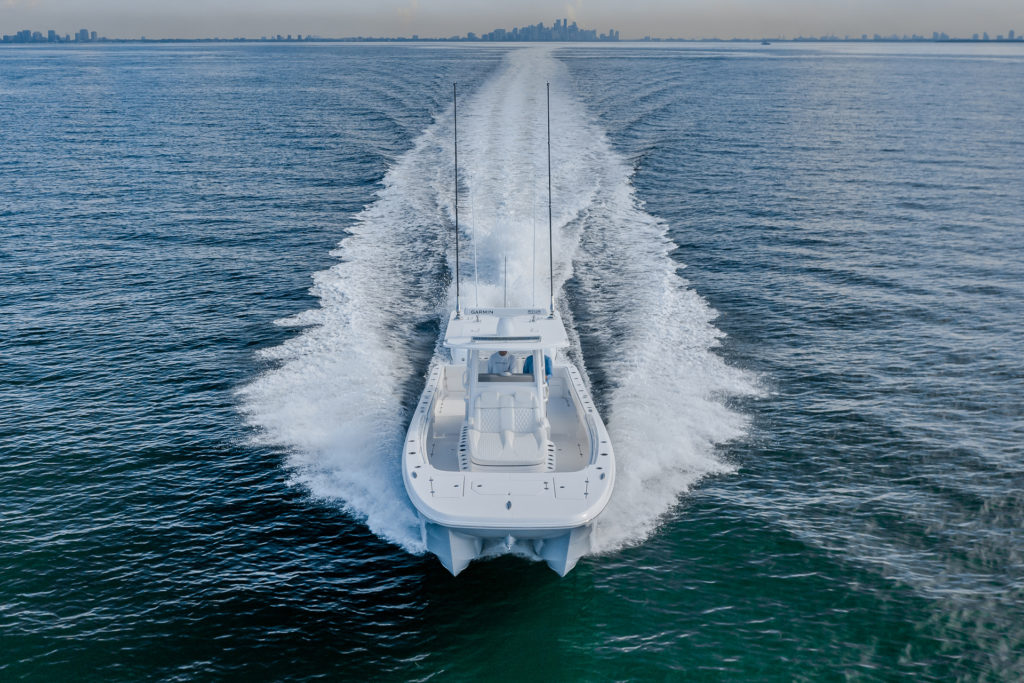
33′ Catamaran
Performance, in a more concentrated form..
Five years ago we teamed up with Morrelli & Melvin for the first time to show the world what a catamaran can truly achieve. Now it’s time to do it again with our smallest platform yet. We took the unprecedented performance, versatility and amenities of our model lineup and packaged it in a powerful, agile and nimble new form. Introducing the new Invincible 33’ Catamaran. A whole new size of serious.
Specifications
Length overall, dead rise at transom, weight with power*, standard fuel capacity.
400 GALLONS
1,514 LITRES
Maximum Horsepower
*weight is listed as “ready to fish” which indicates full fuel and livewells..

Insulated Fish Box
Forward Side Storage
Anchor Locker
Bilge Access
Photo Gallery
Highlighted features.
- Single level deck
- 360 walk around fishability
- Patented catamaran hull design
STANDARD FEATURES
- Above and Below Deck Livewells
- AGM Sealed Batteries
- Built-In Anchor Locker
- Deluxe Console with Fully-Lined Interior-Room for Full-Sized Head
- Under Deck Storage
- Finished Bilge
- Under Gunnel Lighting
- High-Speed Pickup for Livewell Seachest
- Interior Console Lights
- Saltwater Washdown
- Three Automatic 2,000 GPH Bilge Pumps
- Waterproof Switches and Circuit Breaker Protected System
- 100% Vinylester Resin Hull
- 316 Stainless-Steel Hardware
- Vacuum-Bagged Cored Hull Construction
POWER OPTIONS
- Twin 300 Yamaha
- Twin 300 Mercury Verado V8
- Twin 400 Mercury Verado
- Twin 450 R Mercury Racing (5.44”)
CUSTOM TOP OPTIONS
- Folding Tower w/ Dual Station
- Hard Buggy Top Upgrade
- Crows Nest for Hardtop w/ Ladder
- LED Spreader Lights (each)
- Rupp Top Gun Revolution Outriggers
- Rupp Carbon Fiber Outrigger Upgrade
- Gem Deluxe Outriggers w/ Carbon Fiber Poles
- Gem 22′ Outrigger Upgrade (pair)
- Rod Holders for Back of Hardtop (6)
- Kingfish Rodholders (pair)
- 3 Panel Polycarbonate Enclosure
- 2 Panel Polycarbonate Wings
- Windshield Enclosure
- Windshield Tempered Glass Upgrade
- Windshield 2 Panel Polycarbonate Wings
- Hardtop Rear Support Legs
- Double Rod Rack Upgrade (needs rear support)
FISHING ACCESSORY OPTIONS
- Rod Holders on Side of Gunwale Additional (each)
- Rod Holders on Console Vertical (each)
- Rod Holders on Coffin Box (each)
- Heavy Duty Swivel Rod Holders (each)
- Livewell Seachest 2 pumps
- Livewell Seachest 3 pumps
- Livewell Seachest 4 pumps
- Large Livewell Seachest 6 pumps
- Additional High Speed Pickup
- Above Deck Livewell Connections (each)
- Clear Plexiglass Lid for Livewell (Floor Well)
- Under Gunnel Rod Racks (each)
- Under Gunnel Gaff Holders (each)
- Electric Reel Outlets (each)
- Colored Livewell (each)
- Livewell Light (each)
- In Floor Livewell – 70 gallons
SEATING OPTIONS
- Twin Custom Llebroc Helm Chairs
- Deluxe Back to Back Helm Seat w/ Built in cooler
- Rear-facing Tackle Station Upgrade
- Rear Bench Seating (Removable)
ENHANCEMENT AND CONVENIENCE
- Fancy Rigid Rubrail with Stainless Insert
- Dive Ladder – Transom Pullout Style
- Fresh Water Washdown
- Hose Coil Kits for Fresh and Salt Washdowns
- Additional Hose Coil Kit for Salt Washdown
- Additional Hose Coil Kit for Fresh Washdown
- Deluxe Electric Head in Console
- Windlass in Hull w/ Custom Anchor and Bracket
- SS Towing Eye Strike Plate Package
- Under Water Lights LED – Blue & White (each)
- Extra House Battery – AGM
- Battery Charger with Galvanic Isolator
- Stainless Steel Cupholders on Gunwale (each)
- Ultra Junior Float Switch Upgrade (each)
- Upper Console Keeper
COLORS AND CANVAS OPTIONS
- Custom One Color Gelcoat for Hull
- Full Coaming Bolsters
- Seadek Helm Pad
- Seadek Console Exterior Package
- Seadek Console Interior Package
COVER AND SHADE OPTIONS
- Forward Bahama Shade
- Aft Bahama Shade
- Extended Console-Coffin Cover
- Leaning Post Cover
- Motor Cover (each)
- Second Station Box Cover

- 27′ Gen 2
- 31′ AmeraCat
- Commercial Cats
- 27′ Gen II
- Fish Pictures
- Charter an AmeraCat
- Our Build Process
- Accessories
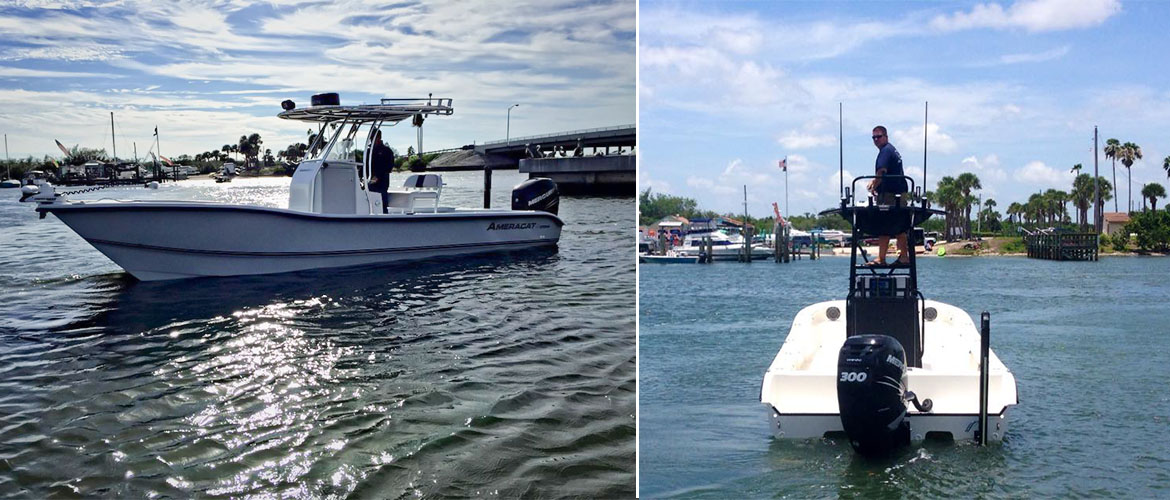
25' AmeraCat
The 25' AmeraCat is the first ever fully functional single engine catamaran fishing boat. The 25' AmeraCat is now available to the public.
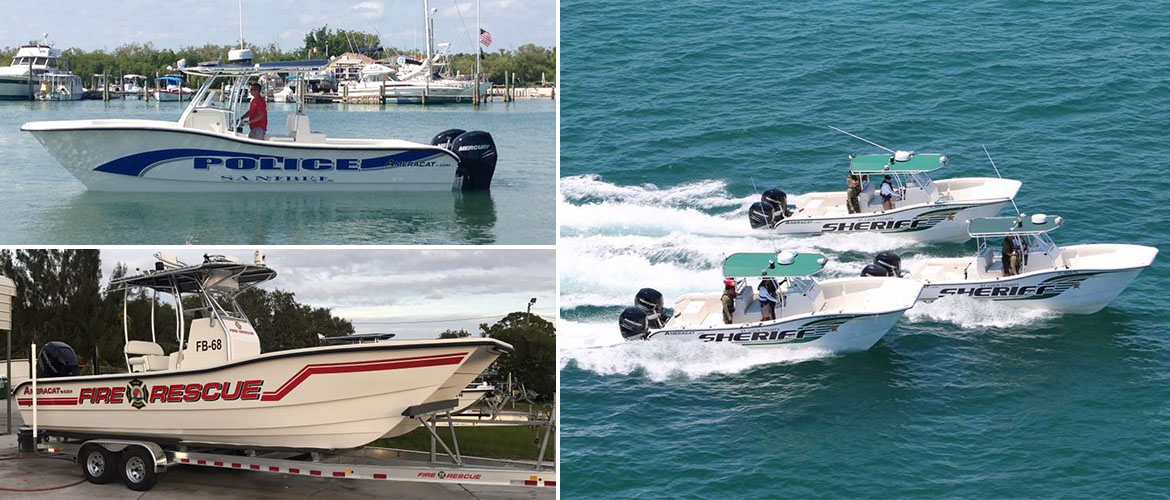
Commercial Catamarans
AmeraCat is an exceptional platform for many types of government, law enforcement, and commercial use. AmeraCat is presently in service with St. Lucie county Sheriff’s Office, Fort Pierce Police Department, Dixie County Sheriff’s office, Sanibel Island Police Department and Ft. Pierce Harbors Pilot’s Association meeting and exceeding their expectations for tactical operation requirements everyday on the water.
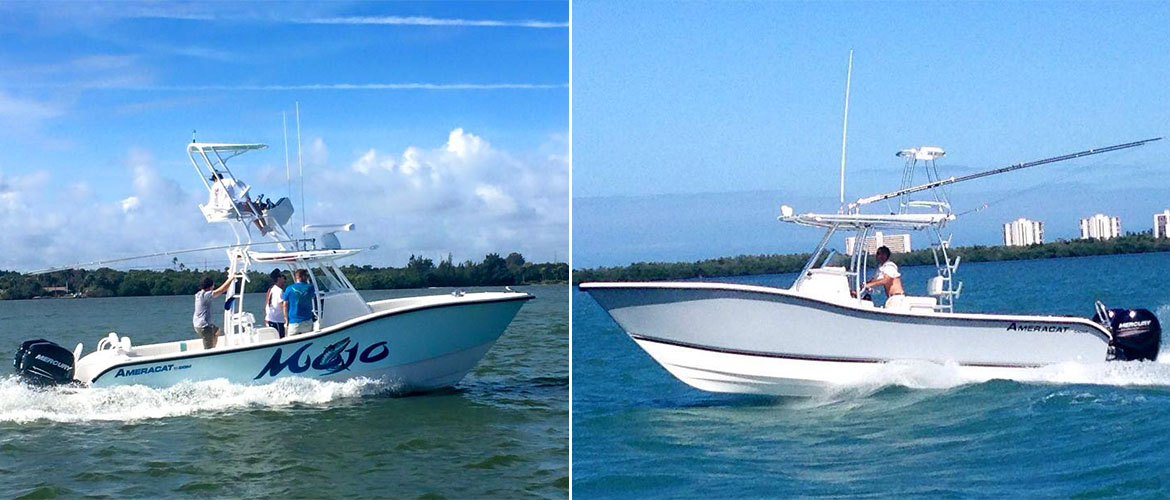
27' AmeraCat
AmeraCat took the original 27′ Gen1 power catamaran and changed things up a little. We added higher gunnels, more displacement and added more interior space by increasing the beam to 9′. The 27′ Gen2 is great for any recreational or commercial use and can be fully customized to meet your needs. With great handling from this center console fishing boat, docking the 27′ Gen2 is a breeze.
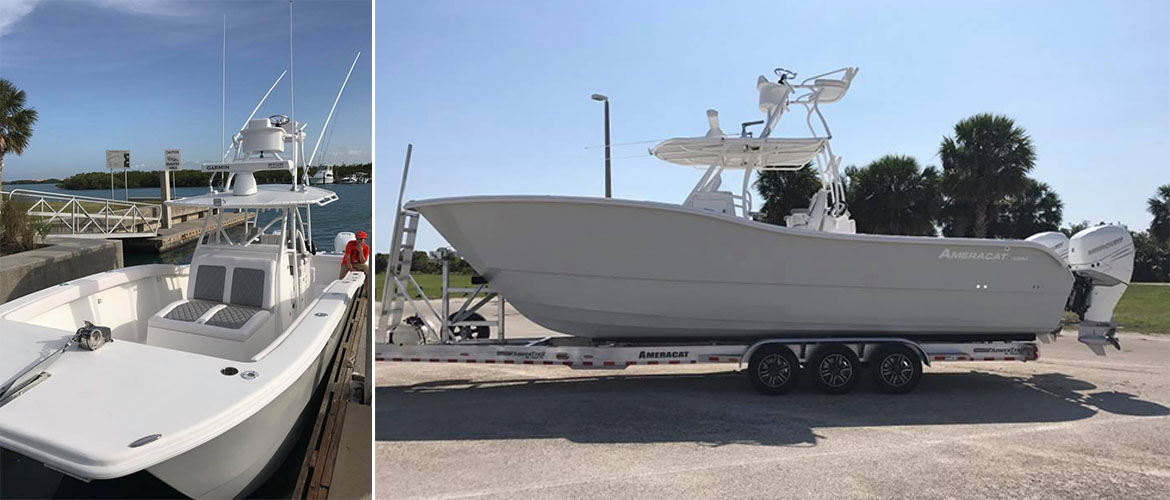
31' AmeraCat
AmeraCat wanted to design a power catamaran that was in between 27′ and 39′, that is why we created the 31′ AmeraCat center console power catamaran. We feel that for the sport fisherman, this is one of the best offshore fishing power catamarans we offer. Great for Charter Boat Captains as well as the everyday fisherman.
AmeraCat Custom Catamarans
If you are ready to demo one of our Commercial or Recreational Offshore Fishing Catamarans, click the link below or call us directly at (772)359-3641.
Call Us Now
Recreational Catamarans

AmeraCat Power Catamarans
AmeraCat offers a variety of Center Console Fishing Catamarans, ranging from our 25' AmeraCat Hybrid to our 39' AmeraCat. All of our models are made with NO WOOD, rather with high density foam and hand laid construction. All of our offshore fishing catamarans are custom built to your specifications and you always deal with an owner of the company, not a salesman. Click below for more information.

Commercial Power Catamarans By AmeraCat
AmeraCat is an exceptional platform for many types of Government, Law Enforcement, Towing vessel and any Commercial use. AmeraCat is presently in service with St. Lucie County Sheriff's Office, Fort Pierce Police Department, Dixie County Sheriff's office, Sanibel Island Police Department and Ft. Pierce Harbors Pilot's Association meeting and exceeding their expectations for tactical operation requirements everyday on the water.
Build-A-Boat


Build Your Own Custom Catamaran With AmeraCat
Choose all of your upgrades and choose all of your own unique specifications for your new AmeraCat Fishing Boat. We have many different options to add to your new Power Catamaran. Add features like additional rod holders, outriggers, down riggers, dive platforms, bolster cushions, or any of our custom upgrades. We want you to build your offshore fishing catamaran just the way you want it. Click the link to create your custom catamaran.
Options/Accessories

Options To Fit every Need
When it comes to creating your custom offshore Fishing Catamaran, it is important to have all of the accessories you need. Whether creating an offshore fishing machine, dive boat or just your regular offshore cruising boat we have all of the custom options you could need. We design everything unique to your own specifications. We want you to be able to have your boat just the way you want it. We have below a few options for you to view. Be sure to add any custom options in the Build-A-Boat form when you are ready to design your AmeraCat.
Privacy Overview
- Welcome To Tom George Yacht Group
- 727-334-8707
- Locations & Hours

TGYG LIFESTYLE BLOG
Catamaran fishing boats: why you should consider an offshore multihull boat.
- August 27, 2020
The market for offshore catamarans has exploded in recent years, and catamaran fishing boats are driving much of the surge in popularity. Newer catamarans are bigger, faster, highly fuel efficient and a near ideal fit for the angler on the west coast of Florida that needs to run 50 to 100 miles to his favorite fishing spot. The new breed of catamaran fishing boats not only have impressive range and quality of ride, but new designs bring about improved handling that might even convert the most fervent monohull enthusiast.
With the ever increasing power of outboard engines on the market today, manufacturers are emphasizing larger catamaran models. The notable catamaran brands such as Invincible focus on the 35-foot to 46-foot range of models. These larger cats are spacious, can hold a massive amount of fuel with space to store all your gear and belongings and offer a better ride quality than previous generation, smaller catamarans.
Catamarans vs. V-Hull (Monohull)
Much of the discussion when comparing the multihull catamaran design with a standard V-hull or monohull design surrounds ride quality. Ride quality of course can mean a number of things such as how the boat deals with rougher conditions, stability at rest, handling and more.
The multihull design of a catamaran fishing boat is well known for reducing vessel roll at rest and at trolling speeds. Increased stability is a key attribute of any multihull boat when compared to a monohull.
Generally speaking, when running in rougher seas, the catamaran’s multiple sharper hulls will slice through the water providing a very comfortable ride. Catamarans typically won’t handle hard turns as well as a monohull since the multihull vessel will tend to remain flat or even lean outboard, but newer designs and innovations have narrowed the gap between monohulls and catamarans in this area. Invincible catamarans even introduce a lean into the turn helping mimic the handling of a monohull. Still, even with these gains in handling ability, experienced boaters can tell a difference between the monohull maneuverability at speed compared to a multihull.
Worth noting also is the spaciousness provided by the multihull design. Because the beam is carried forward, giving the deck a more rectangular shape, there is more space to move around.
The multihull design does more than just provide additional stability and deck space. Because less of the boat is sitting in the water as a result of two hulls, the fuel economy on catamaran fishing boats is outstanding. Less displacement means a more efficient fuel burn. Combine the efficiency with the bountiful storage, and you’ve got a range on offshore cats worthy of anyone’s consideration.
Whether you need a center console capable of carrying 800 gallons of fuel or just need storage for all of your supplies for a few days in the Bahamas, a multihull can meet these needs.
Catamaran Fishing Boats by Invincible
When Tom George Yacht Group sought to carry a line of catamaran fishing boats for TGYG customers on the west coast of Florida, Invincible was the ideal fit for a number of reasons. While other manufacturers have introduced catamaran models adjacent to existing boat lines, no manufacturer invested the time, money and research & development resources into a launch of high performance catamaran models like Invincible.
Invincible hired legendary naval architecture firm Morelli & Melvin – renowned for catamaran racing hull design – to assist in the design of Invincible’s first offshore catamaran. The significant investment of time and resources led to the hybrid, semi-asymmetric design for which Invincible catamaran hulls are known. These boats are made to be fast and highly fuel efficient, but they’re also made to handle. The patented hull design enables high speed maneuvering turns unlike any similar-sized catamaran on the market.
As Invincible says, “no other catamaran possesses the seakeeping abilities of an Invincible hull without the aid of trim tabs or ballast tanks.”
The success of the 40 catamaran launch paved the way for the roll-out of the smaller 37 and 35 and now, also, the 46. The result is a lineup of offshore catamarans customers love and competitors envy.

For the customer, the ability to customize an Invincible catamaran is impressive. Everything from cup holder placement to rod holders, from the seating configuration to the type of windshield can be perfectly dialed into a customer’s exact needs and desires. Overwhelmed by too many options? The TGYG team can help guide you through the process. Simple put, when you purchase a catamaran, Invincible bends over backwards to meet your every need.
For the Florida west coast angler where long runs are typical, the Invincible offshore cat might be an ideal fit. As a general rule, every model in the Invincible line has a minimum 400 mile range at 40 mph. With the Invincible 40 catamaran, that range gets you over 650 miles at 40 mph.
Interested in learning more about catamaran fishing boats or the Invincible line of offshore catamarans? Please feel free to contact Tom George Yacht Group. Our team can help guide you towards the right boat for your experience and needs to help ensure maximum long-term satisfaction on the Florida waters
Stay Connected.
Sign up for updates and special offers..
- New Inventory
- Pre-Owned Inventory
- Sell Your Boat
Service & Parts
- Book An Appointment
- Extended Service Contract
- Parts Request
- Marine Insurance
- Payment Calculator
Visit & Contact
- Our Locations
DISCLAIMER We strive to ensure all pricing and information contained in this website is accurate. Despite our efforts, occasionally errors resulting from typos, inaccurate detail information or technical mistakes may occur. We are not responsible for any such errors and reserve the right to correct them at any time.
- Privacy Policy
- Terms Of Use
- Cookie Policy
- Accessibility Statement
- Do Not Sell My Info
This site is protected by reCAPTCHA and the Google Privacy Policy and Terms of Service Apply.
Copyright © 2024 Tom George Yacht Group. All Rights Reserved. Powered by Revver Digital
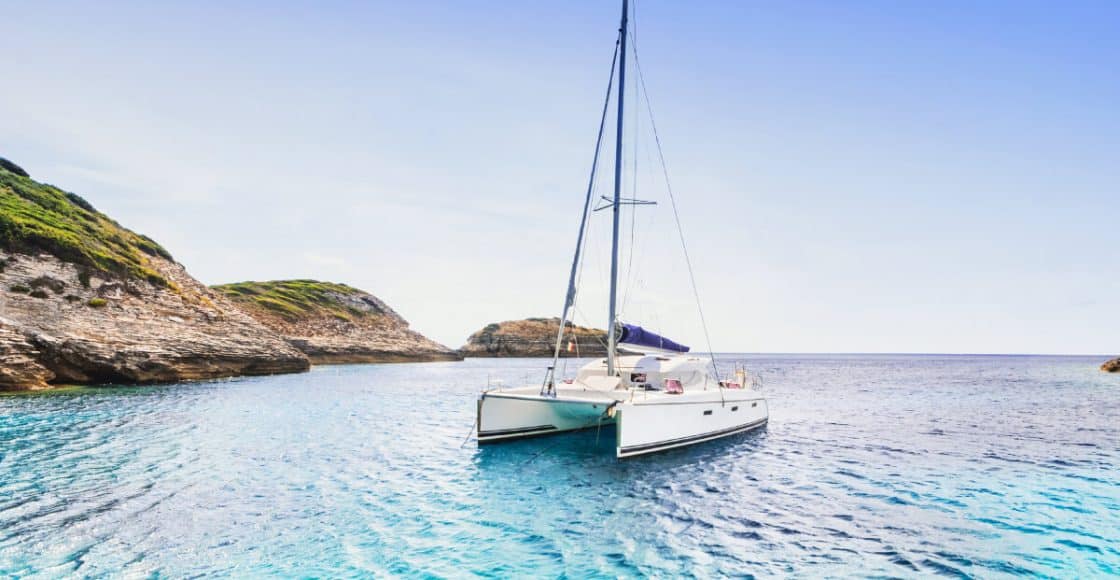
10 Best Catamarans for 2023

Table of Contents
Catamarans have taken the boating world by storm, becoming the fastest-growing segment, with both sail and power cats dominating the market. Some of the best catamarans have been launched in the past 12 months! Let us introduce you to five power catamarans and five sail multihulls, and then let us get you on the water with one! Here are the ten best catamarans for 2023 :
- World Cat 260 CCX
- Four Winns TH36
- Leopard 40 PC
- Aquila 42 PC
- HammerCat 45
- Fountaine Pajot Tanna 47
- Bali 4.4
Balance 442
- Minicat 310
Find the market’s hottest catamarans for half-day and full-day rent
Power Catamarans:
World cat 260 ccx.
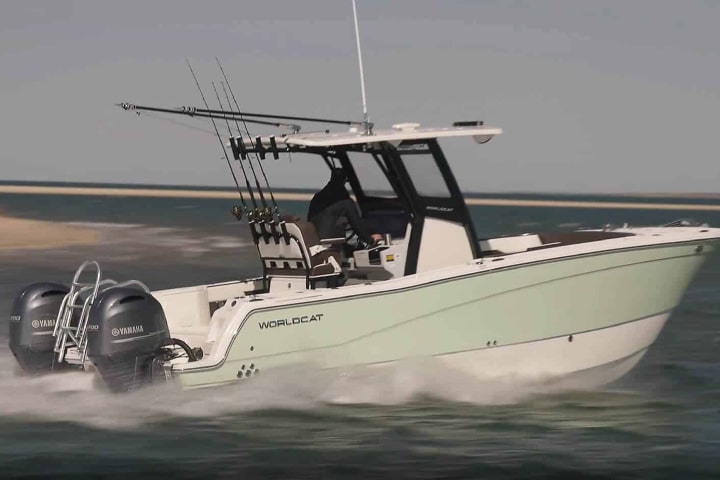
Image Source: https://worldcat.com/models/260cc-x/
The sixth model in the builder’s center console line , the World Cat 260 CCX , is compact but packed with features, including a wraparound U-lounge for relaxing or casting, a 30-gallon live well, a 120-quart insulated fish box and twin 200-hp outboards that draw on 180 gallons of fuel. This is a small but serious fishing machine.
Four Winns TH36
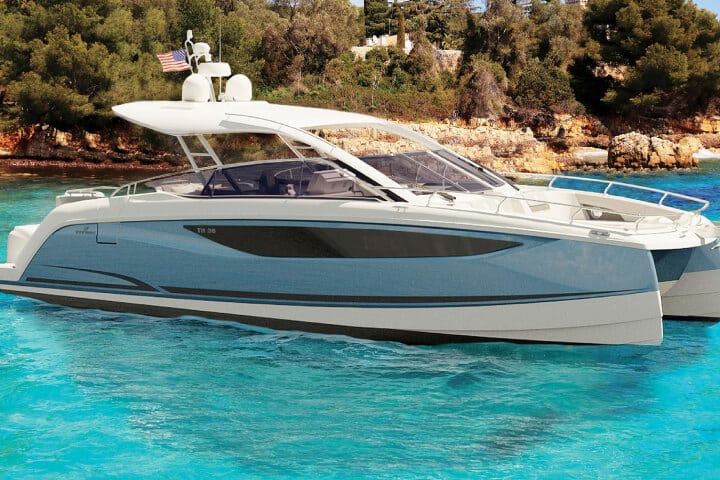
image source: https://www.fourwinns.com/new-era
The new Four Winns TH36 is the first outboard-powered catamaran introduced by the builder. The dual console design has a walkthrough windshield and room for 15 or more guests. Power is provided by twin 300-hp outboards upgradeable to 350s, making this runabout speedy and fun.
Leopard 40 PC
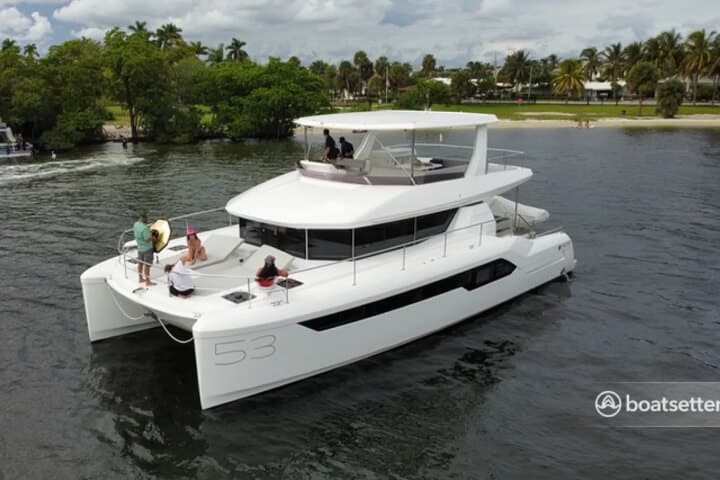
Joining her 46- and 53-foot siblings, the new Leopard 40 PC is a couple’s cruiser with many of the same features as the two larger models but on a much smaller (and for some, more approachable) platform. Engine packages range from 250 hp to 370 hp, and a top speed of 20 knots is expected.
Aquila 42 PC
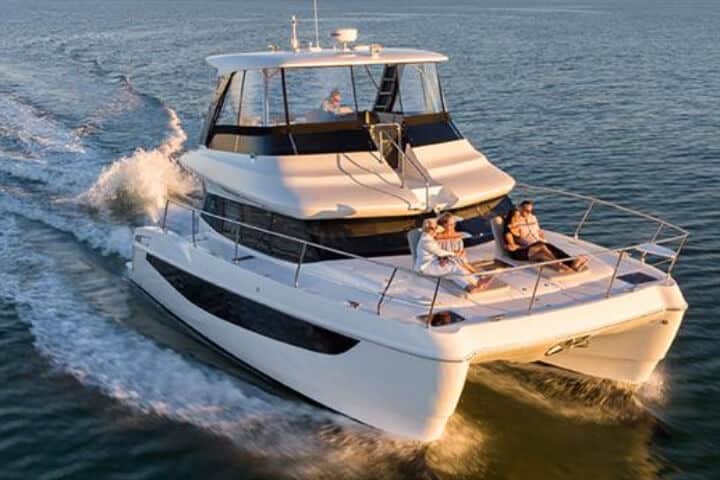
Image Source: https://www.aquilaboats.com/news/42-yacht
The new 42 falls in the middle of the Aquila range and offers two staterooms, multiple sunbeds, a utility cabin , and numerous layout configuration options. She has engines from Volvo Penta and a spacious flybridge with steps that lead directly down to the foredeck for easy maneuvering.
HammerCat 45
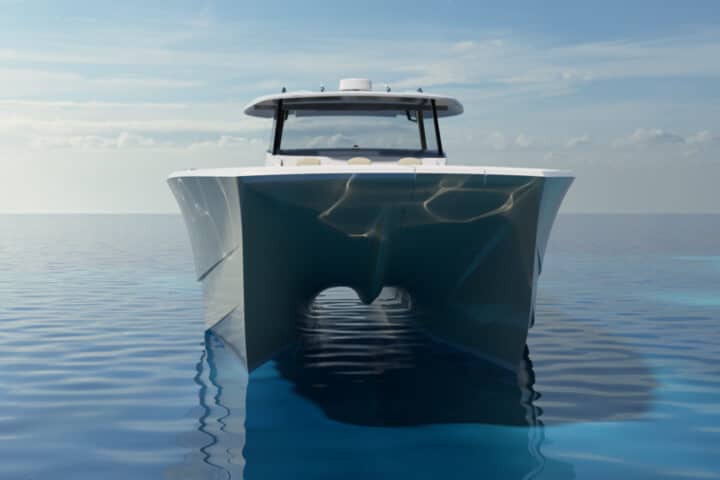
Image Source: https://www.multihulls-world.com/news-catamaran-trimaran/hammercat-45-an-almost-unlimited-program
The new HammerCat 45 is versatile and can work as a sportfish platform, a dive boat, a day cruiser, or a superyacht tender. This center console has a hardtop and a Carolina bow and is built in epoxy and carbon fiber to keep weight down and performance up. Expect a 55- knot top end and a 30-knot cruise depending on the engine package selected.
Sailing Catamarans:
Fountaine pajot tanna 47.
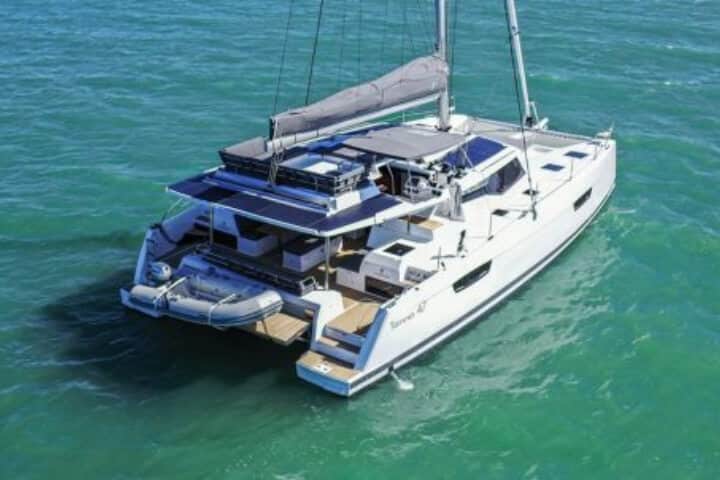
Image Source: https://www.catamarans-fountaine-pajot.com/en/sailing-catamarans/catamaran-tanna-47/
This French-built sailing cruiser has space in spades. The new FP Tanna 47 is based on (and shares a hull design with) her predecessor, the Saona 47, but clever tweaks have made this a whole new boat. The cabin house and deck have been revamped, the flybridge is 40% larger, the salon/ galley has gained storage options, and the helm is more ergonomic than before.
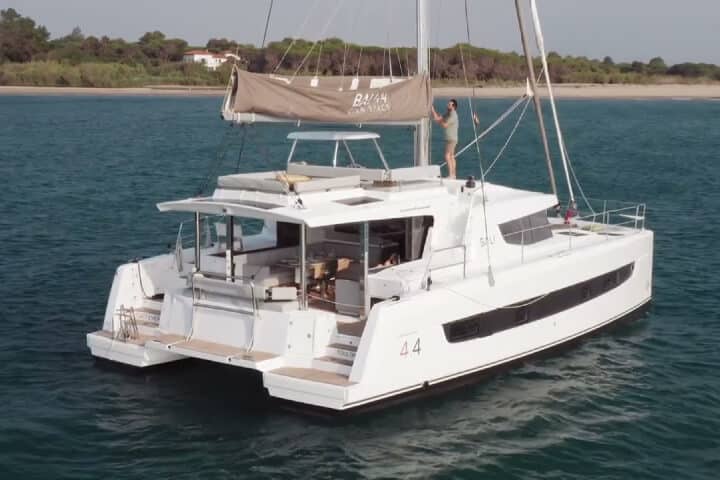
Video Source: bali-catamarans.com
Bali has captured the hearts of sailors who love lots of living space, large household-style appliances, and simplicity. Bali cats are unique for their combination salon/ cockpit layout, and the 4.4 joins her siblings in this groundbreaking design. With the touch of a button, a “garage door” lifts, connecting the indoors with the outdoors with minimum redundancy in living arrangements.
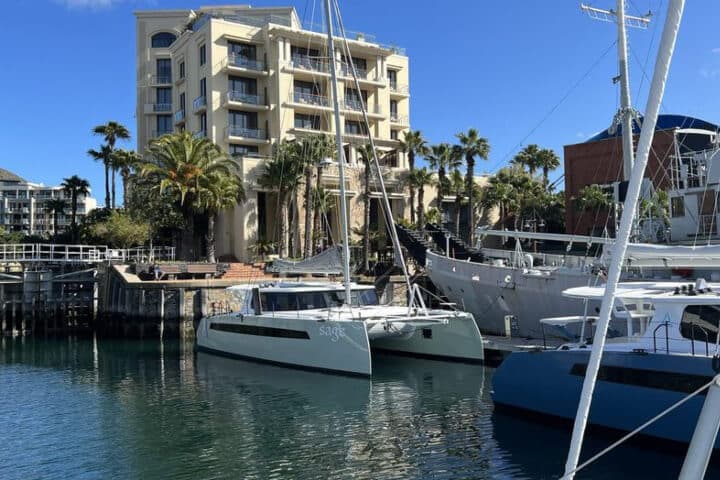
Image Source: https://balancecatamarans.com/balance-442/
Fast and packed with proven cruising features, the Balance 442 is the little sister to last year’s 482. Perfectly sized for couples, this boat was designed for distance cruisers by distance cruisers. There’s even an option for a large solar array to make living at anchor easy and just about carbon neutral.
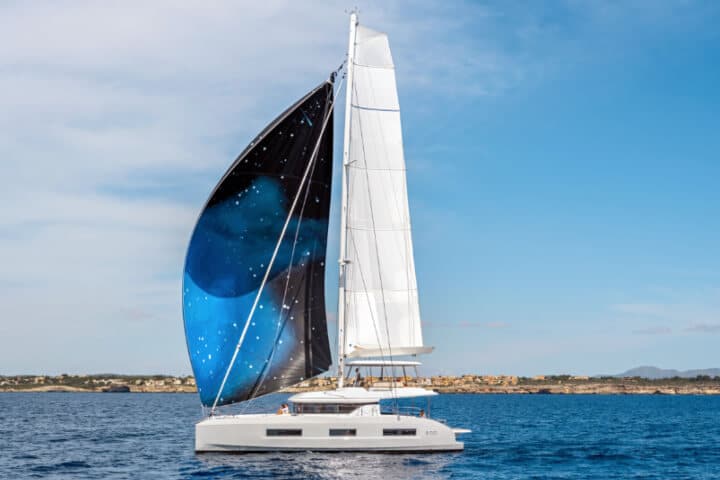
Image Source: https://www.cata-lagoon.com/en/55
French catamaran builder, Lagoon, has introduced a new VPLP-designed cruising cat that you can test in charter soon. The Lagoon 55 slots just above the newly introduced 51and are offered as a large and comfortable flybridge model with up to six cabins to accommodate an overnight crowd.
Minicat 310
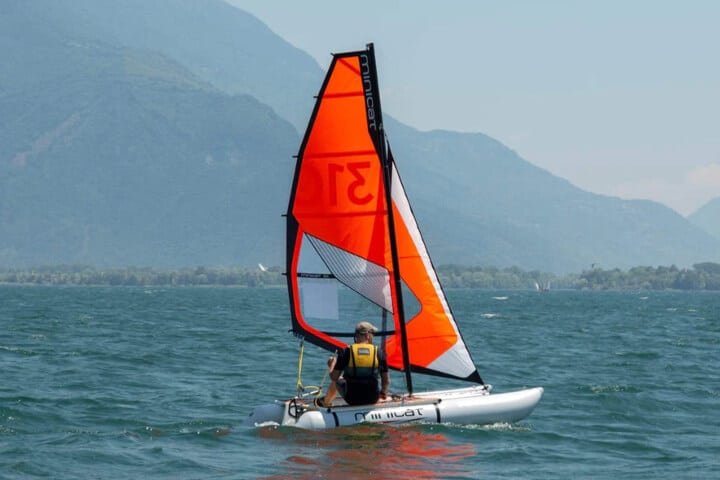
Image Source: https://redbeardsailing.com/products/minicat-310
Not all cats are of the large, expensive fiberglass variety. An affordable multihull can be had in Europe’s Minicat 310 Sport, an inflatable beach cat weighing only 77 pounds and packing down into a single bag. This cat has sophisticated big boat features like roller furling, a fully battened mainsail, keels, and an attachment for a small outboard.
Find catamarans for rent— NEAR YOU
These models, representing some of the best catamaran brands on the market today, are pretty new, so there aren’t many out there yet, but if you get a chance to step aboard one, you won’t be disappointed. One way to potentially test one is via a peer-to-peer boat-sharing service like Boatsetter that pairs owners, who can offset boat ownership costs, with charters, who can enjoy luxury boats without the long-term commitment.
Check out the hottest boats in the market at Boat Types , and scroll through Boat Guises to find your next boating destination . Keep your eyes peeled to catch one of these ten amazing catamarans on the water!
About Boatsetter
Boatsetter is a unique boat-sharing platform that gives everyone — whether you own a boat or you’re just renting — the chance to experience life on the water. You can list a boat , book a boat , or make money as a captain .
List. Rent. Earn— Only at Boatsetter

Zuzana Prochazka is an award-winning freelance journalist and photographer with regular contributions to more than a dozen sailing and powerboating magazines and online publications including Southern Boating, SEA, Latitudes & Attitudes and SAIL. She is SAIL magazines Charter Editor and the Executive Director of Boating Writers International. Zuzana serves as judge for SAIL’s Best Boats awards and for Europe’s Best of Boats in Berlin.
A USCG 100 Ton Master, Zuzana founded and manages a flotilla charter organization called Zescapes that takes guests adventure sailing at destinations worldwide.
Zuzana has lived in Europe, Africa and the United States and has traveled extensively in South America, the islands of the South Pacific and Mexico.
Browse by experience

Explore articles
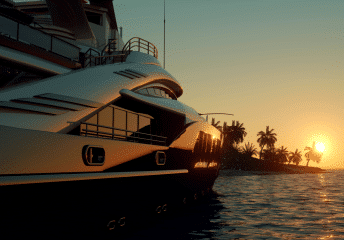
How to Rent a Yacht
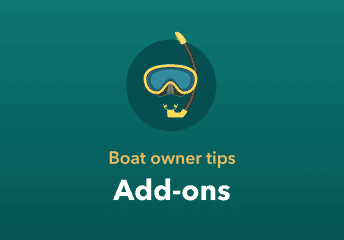
Top 5 Add-ons that Attract Renters
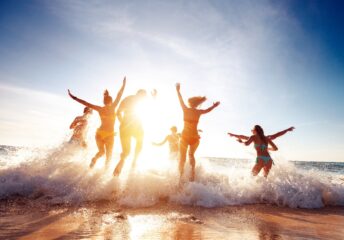
Best Spring Break Destinations (Plus, A Roundup of Unique Boats)
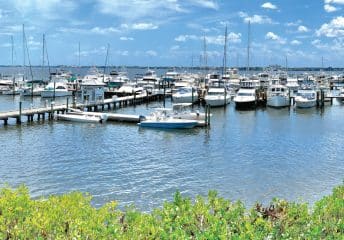
Top 5 Marinas in Port St. Lucie, Florida

How To Sail A Catamaran? (A Detailed Step-By-Step Guide)
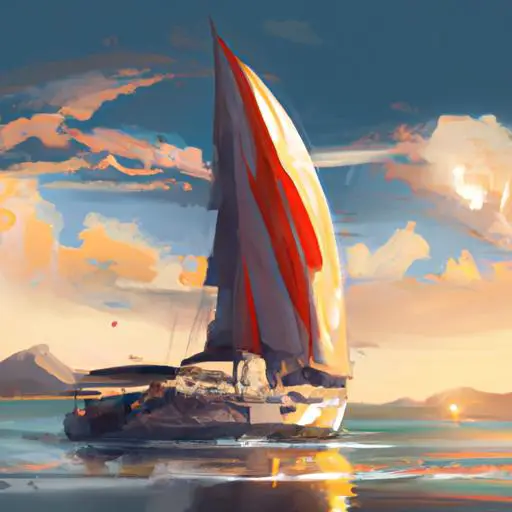
Are you an adventurous soul looking for an exciting way to explore the open waters? If so, then sailing a catamaran may just be the perfect activity for you! Catamarans are becoming increasingly popular for sailing due to their stability and speed, and when sailed correctly, can be a powerfully enjoyable experience.
This guide will walk you through the basics of sailing a catamaran, from understanding the basics of sailing to handling the boat in different conditions and beyond.
Here, we will cover the differences between a monohull and a catamaran, balancing the boat, basic sailing techniques, safety precautions, and tips for improving your catamaran sailing skills.
So grab your gear and lets get sailing!
Table of Contents
Short Answer
Sailing a catamaran is relatively straightforward.
To get started, adjust the sails and rudder to the desired angles.
Next, begin to move forward using the power of the wind and the force of the sails.
While underway, make sure to constantly adjust the sails and rudder to maintain the desired course.
Finally, when ready to stop, lower the sails and use the rudder to bring the catamaran to a stop.
Understanding the Basics of Sailing
Learning how to sail a catamaran can be an exciting and rewarding experience, but before you can take to the open waters you need to understand the basics of sailing.
It is important to familiarize yourself with the fundamentals of sailing, such as understanding wind direction and how to use sails.
Knowing the basics is essential for anyone wanting to sail a catamaran, as it will allow you to make informed decisions when sailing and will help keep you safe on the water.
Understanding wind direction is a key part of sailing, as it will help you determine the best way to sail and how to use the sails to propel the boat in the desired direction.
This can be done by looking at the flags or flags on other boats in the area, as well as by analyzing the behavior of the waves and the wind.
Additionally, you should also learn the different points of sail, which are the directions a boat can sail relative to the wind.
In addition to understanding wind direction, it is also important to understand how to use the sails of a catamaran.
The sails of a catamaran are made up of two mainsails, which are the two large sails on either side of the boat, as well as a jib, which is a smaller sail located at the front.
Knowing how to properly set the sails will allow you to make the most of the wind and propel the boat in the desired direction.
Additionally, you should also learn how to trim the sails, as this will help you to optimize the boats performance in different wind conditions.
Understanding the basics of sailing and how to use the sails of a catamaran is essential for anyone wanting to learn how to sail a catamaran.
With the right knowledge and practice, sailing a catamaran can be an incredibly rewarding experience.
The Differences Between a Monohull and a Catamaran

When it comes to sailing a catamaran, it is important to understand the differences between a monohull and a catamaran.
A monohull is a single-hulled boat with a keel that runs along the bottom of the boat.
This helps keep the boat stable and upright in the water.
A catamaran, on the other hand, has two hulls which are usually connected by a bridgedeck.
This helps to create a more stable platform in the water and allows for more open space on the boat.
There are some important differences between sailing a monohull and a catamaran.
For example, a monohull requires more power to move through the water and is more limited in terms of maneuverability.
On the other hand, a catamaran is more maneuverable and can be sailed in a variety of conditions.
Additionally, a catamaran is inherently more stable in the water and can handle larger waves.
Another important difference between a monohull and a catamaran is the way they are balanced.
A monohull relies on its keel for stability and must be balanced evenly along the length of the boat.
On the other hand, a catamaran relies on the two hulls to remain balanced and can be sailed with one hull slightly higher than the other.
This allows for greater maneuverability and can help to reduce drag in the water.
Finally, a catamaran is more efficient than a monohull and can be sailed at higher speeds for longer distances.
This makes it ideal for longer trips and open-water sailing.
Balancing the Boat
When it comes to sailing a catamaran, one of the most important steps is learning how to balance the boat.
This is because catamarans have two hulls, which means that they have twice the length and twice the width of a single-hull boat.
This can make it more difficult to keep the boat upright and stable in the water.
When sailing a catamaran, it is important to keep the hulls balanced so that the boat remains stable.
The easiest way to do this is to make sure that the weight is evenly distributed between the two hulls.
This can be done by ensuring that the sail is properly adjusted and that the passengers are sitting evenly between the two hulls.
Additionally, it is important to keep an eye on the wind direction and make sure that the sails are adjusted accordingly.
Furthermore, it is important to be aware of the boats center of gravity.
This is the point at which the boats weight is evenly distributed between the two hulls.
If the boat is not properly balanced, then it can become difficult to control, especially in rough conditions.
It is important to be aware of the boats center of gravity at all times and adjust the weight distribution accordingly.
Finally, it is important to remember that cats are less forgiving than other types of boats.
This means that any errors in balance or sail trim can be exaggerated and lead to a dangerous situation.
Therefore, it is important to practice balancing the boat in calm waters before venturing out in rougher conditions.
By following these steps, sailing a catamaran should be a rewarding and enjoyable experience.
With the right knowledge and practice, anyone can learn how to sail a catamaran safely and confidently.
Handling the Boat in Different Conditions

When sailing a catamaran, it is important to understand how to handle the boat in different conditions, such as in waves and strong winds.
In wave conditions, the key is to keep the boat balanced.
This means keeping the weight evenly distributed between the two hulls and using the sail to keep the boat stable.
To do this, you can adjust the angle of the sail and the trim of the boat to match the waves.
It is also important to keep an eye on the wind direction, as this can affect the boats stability.
In strong winds, it is important to know how to properly balance the boat.
This means keeping the weight evenly distributed between the two hulls and using the sails to keep the boat stable.
You can adjust the trim of the sail and the angle of the sail to match the wind direction.
It is also important to keep an eye on the wind speed, as this can affect how much power you need to use in the sails.
Finally, it is important to know how to handle the boat in rough weather.
This means using the sails to provide stability and keeping the boat balanced in rough conditions.
You should also be prepared to use the outriggers, which are the stabilizers that run along the sides of the boat, to help keep the boat upright in strong winds.
By familiarizing yourself with the basics of sailing and understanding how to handle the boat in different conditions, such as waves and strong winds, you can become a confident and skilled catamaran sailor.
With practice and experience, you can explore the open water with confidence and enjoy the unique experience of sailing a catamaran.
Basic Catamaran Sailing Techniques
Sailing a catamaran can be a great way to explore the open water and experience the thrill of the sea.
Before you set out, however, its important to understand the basics of sailing, such as wind direction and how to use sails.
Once youve got the basics down, you can then start to learn the specifics of how to sail a catamaran.
The most important thing to understand is the difference between a monohull and a catamaran.
Catamarans have two hulls, which make them more stable than monohulls.
This means you will need to learn how to properly balance the boat, as the two hulls can move independently of each other.
You should also be aware of the wind and current when youre sailing, as these can affect the boats stability.
When youre ready to start sailing, youll need to make sure that the sails are set properly and the boat is balanced correctly.
To do this, youll need to be aware of the wind direction and adjust the sails accordingly.
You should also make sure that the sails are trimmed properly, as this will help you to get the most out of the wind.
In order to properly sail a catamaran, youll also need to understand how to handle the boat in different conditions.
This includes handling the boat in waves, strong winds, and other challenging scenarios.
To do this, youll need to be aware of the wind direction, the current, and the waves.
You should also be aware of how the boat responds to different conditions, and be prepared to make adjustments as necessary.
Once youve got the basics of sailing a catamaran down, you can start to explore the open water.
So, dont be afraid to get out on the open water and learn the ins and outs of sailing a catamaran.
With a bit of practice, youll soon be able to enjoy the thrill of the open water.
Safety Precautions for Catamaran Sailing

Before sailing a catamaran, it is important to take safety precautions to ensure your trip is safe and enjoyable.
The first step in doing so is to make sure you have the right safety gear, such as a life jacket, flares, and a first-aid kit.
It is also a good idea to check the weather forecast before departing so you can plan your route accordingly, and to make sure you have the right clothing for the conditions.
Additionally, you should always carry a marine radio on board in case of an emergency.
Lastly, make sure you inform someone of your intended route and estimated time of return, so they can come to your aid in the event of an emergency.
By taking these safety precautions, you can enjoy your catamaran sailing experience to the fullest!
Tips for Improving Your Catamaran Sailing Skills
Improving your catamaran sailing skills is all about getting comfortable with the boat and understanding the different conditions youll be sailing in. Its important to start slowly and build your skill level gradually, as this will help you become a more confident and competent sailor. Here are some tips to get you started:
1. Learn the basics of sailing. Knowing the basics of sailing is essential before you start to learn how to sail a catamaran. Understand the basics of wind direction, how to use sails, and how the wind affects the boat. This will help you better understand the catamaran and how to maneuver it.
2. Familiarize yourself with the catamaran. Spend time familiarizing yourself with the catamaran and its components. Learn the differences between a monohull and a catamaran, such as the two hulls and how to properly balance the boat. You should also be aware of the boats capabilities and limitations.
3. Practice sailing in different conditions. Its important to practice sailing in different conditions, such as in waves and strong winds. This will help you become more comfortable with the boat and give you the experience to handle a variety of conditions.
4. Learn how to use the sails. Understanding how to use the sails will help you become a more efficient sailor and get the most out of your catamaran. Learn how to adjust the sails for different wind directions and how to use them to your advantage.
5. Understand the safety precautions. Before you start sailing, make sure you understand the safety precautions. This includes understanding the weather conditions and the safety equipment you need to have on board.
By following these tips, youll be well on your way to becoming a more confident and competent catamaran sailor.
Learning how to sail a catamaran is a great way to explore the world of sailing and open up a world of adventure on the open water.
Final Thoughts
Whether you’re a seasoned sailor or a novice, knowing how to sail a catamaran can be a great way to get out and explore the open waters.
With the right knowledge and practice, you can become a confident and competent catamaran sailor.
From understanding the basics of sailing, to learning the differences between a monohull and a catamaran, to mastering the techniques of catamaran sailing, this detailed step-by-step guide has all the information you need to become a successful catamaran sailor.
So, what are you waiting for? Get out there and start your catamaran sailing journey today!
James Frami
At the age of 15, he and four other friends from his neighborhood constructed their first boat. He has been sailing for almost 30 years and has a wealth of knowledge that he wants to share with others.
Recent Posts
Does Your Boat License Expire? Here's What You Need to Know
Are you a boat owner looking to stay up-to-date on your license requirements? If so, youve come to the right place! In this article, well cover everything you need to know about boat license...
How to Put Skins on Your Boat in Sea of Thieves? (Complete Guide)
There is a unique sense of pride and accomplishment when you show off a boat you customized to your exact specifications. With Sea of Thieves, you can customize your boat to make it look like your...
- 2024 BOAT BUYERS GUIDE
- SHALLOW WATER FISHING
- Email Newsletters
- Boating Tips
- Boating Safety
Electronics
- Best Marine Electronics & Technology
- Baits & Lures
- Fishing Tackle
- Fishing Travel
- Conservation
- Fishing Knots
- Women in Fishing

2023 Boat Buyers Guide: Catamarans
- By Karl Anderson
- December 27, 2022

The popularity of the multihull (aka catamaran or cat) fishing boats has never been greater, as more and more boatbuilders enter this growing segment of the market. The inherent stability of the catamaran design rolls less with the seas, making fishing offshore less tiresome and more comfortable. Available from 20 to 48 feet, catamarans typically offer a large fishing platform with generous storage and fishing amenities. They are available in a wide variety of deck layouts, including center-consoles, dual-consoles, and even pilothouse and express variants.

Big Picture
The large deck area of a catamaran enables many large underdeck storage lockers and insulated fish boxes in the sponsons. This gives anglers ample room for gear and the day’s catch. The catamaran’s stability, fishability, and smooth ride in rough seas make it attractive to anglers as well as day-cruisers. A center-console version adds 360 degrees of angler access to the rail. With the dual-console design, generous seating behind a beam-to-beam windshield makes for a great family fishing-friendly setup.
Live bait is one of the most popular types of fishing in virtually every coastal zone. To do it successfully requires optimal water capacity and proper flow. The minimum size of the outflow water plumbing should be twice the size of the inflow. The plumbing should have a drain at the bottom to shed scales at the end of the day, as well as a drain at the top of the well to adjust capacity and allow overflow. Above-deck transom-mounted wells should fully flood to the lids when running to keep baits from getting beat up.
Tip: A sump box with multiple pumps in case a pump fails is the best setup for first-rate livewells. Conveniently located inflow and outflow valves make it easy to optimize the flow without tiring your bait from swimming too much in the well.

Rod Storage
Having enough rod holders is essential to be successful for opportunity fishing. Look for vertical rod storage along the console and across the back of the T-top. Many models also have rod holders along the outboard transom wall. Having plenty of gunwale rod holders for drift- and kite-fishing is helpful.
Tip: Placing adjustable swivel rod holders by Gemlux makes deep-dropping, lure-fishing and drifting even easier because they allow your rods to face the direction the baits are fishing, yet they can be swiveled back to keep rods from sticking out of the boat while running and docking.
Manufacturers often offer multiple choices for horsepower, but whatever the choice, the engines must come in pairs. For example, you might order twin outboards (one for each sponson) or four outboards (two for each sponson), but single- or triple-outboard configurations are not common on a cat. Optimal selection should be made based on user load, weight of the boat, ride comfort , performance desires, and best case for resale. It’s a rare day when you can run wide open, but having more horsepower gives better torque at slower speeds and thus better control. Running larger engines slower gives better fuel efficiency too.
Tip: When possible, choose the highest horsepower offered because it typically leads to a better resale value with a shorter sales cycle.
Power steering from engine manufacturer Optimus or SeaStar is essential with the higher horsepower required for larger boats, and it makes installing and operating the upper station in a tower far more practical and comfortable.
With the power demands of electronics, livewell pumps, stereo amps and more, it is wise to have at least two house batteries, and for larger boats, a third or fourth with a multibank charger for dockside. Each engine should have its own dedicated battery as well.
Typically choosing the largest screen or multiple screens that will fit on the console is best-case scenario for ease of use, ergonomics, and visibility. VHF radios, stereo controller, and equipment switches for lighting, pumps, and accessories should all be integrated with greatest visibility and ease of operator reach.

A Tale of Two Hulls
A catamaran rides on pair of hulls, or sponsons, each thinner and sharper than that of a similarly sized monohull boat. The narrow sponsons of the cat tend to slice easily through water to deliver a smooth ride, even in rough seas. At the same time, with the sponsons positioned out to the sides of the boat, cats tend to roll less, thus providing great stability to enhance crew comfort, security and safety. However, cats tend to corner more flatly than a monohull, and some hulls (but not all) tend to lean outward versus inward during a turn.

Experts Say
Newer designs such as Invincible’s Morelli and Melvin-designed semi-asymmetrical sponsons eliminate some of the negatives of the cat design, such as “sneezing,” where water sprays out the front of the boat when hitting a wave. They’ve also controlled the uncomfortable “outboard lean” sensation common in older designs when in a turn. Once transitioned to a catamaran, many become true believers and preach the benefits of the design.
Editor Says: Saltwater fishing cats not only offer superb stability and smooth ride, but some also display exceptional speed and range. I recall one trip out of Key West, Florida, aboard an Invincible 40 Cat with four 350 hp outboards to the Dry Tortugas. It was a 60-mile run, and we made it there in 70 minutes. We caught more fish than our arms could bear, and then dashed back to Key West, arriving in time for cocktail hour on the same day. -Jim Hendricks, Staff Editor, Boating and Fishing Group
- More: 2023 Boat Buyers Guide: More Resources , Catamarans , fishing boats

What’s Good Fuel Economy for a Fishing Boat?

Yamaha Releases New 350 Horsepower Outboard
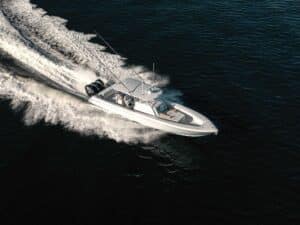
Supersize Center-Consoles Expand Angling Horizons
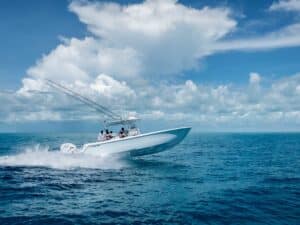
Things To Look For in a Jig-and-Pop Boat
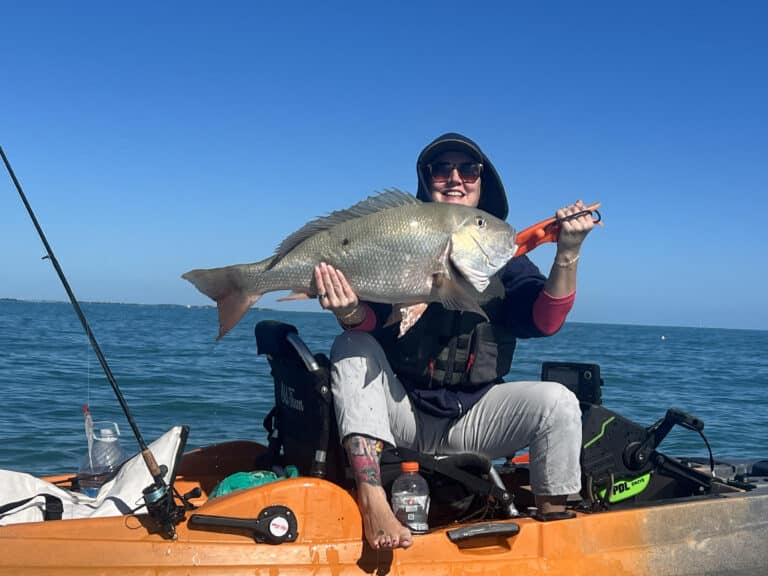
ePDL+ Review: After 30 Trips, Does Old Town’s New Electric Kayak Stand Up to the Hype?
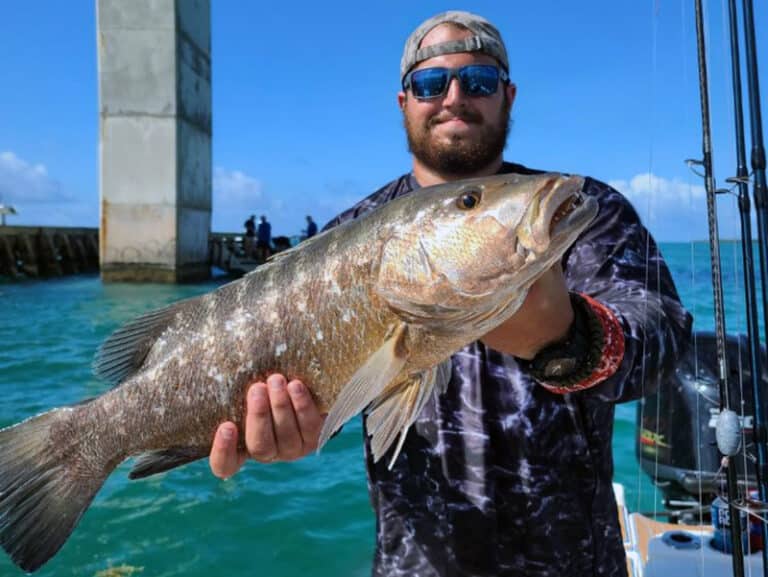
Florida Keys Bridge Monsters
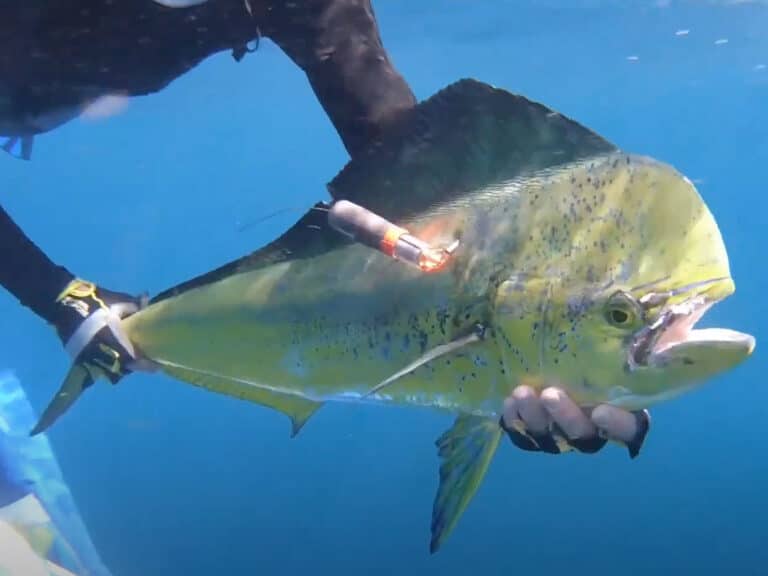
Protect the Blue: Faces of Conservation in the Florida Keys – Lower Keys
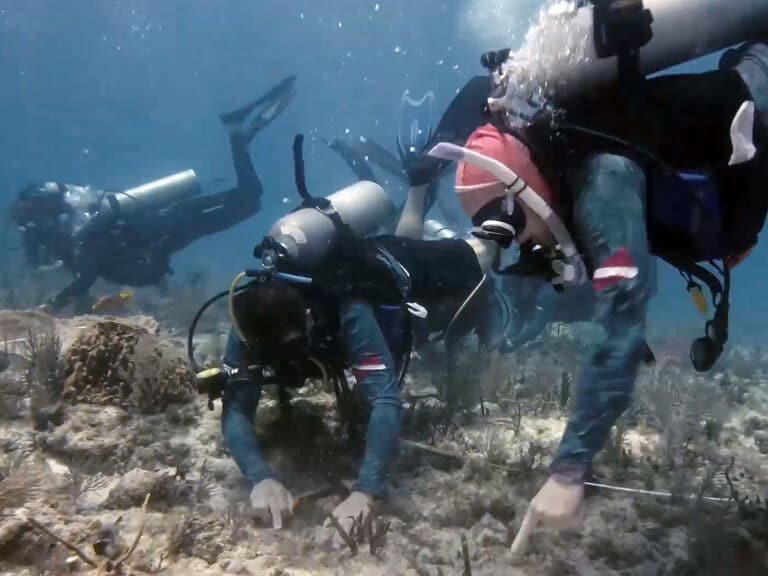
Protect the Blue: Faces of Conservation in the Florida Keys – Key Largo
- Privacy Policy
- Terms of Use
- Cruising World
- Florida Travel + Life
- Sailing World
- Salt Water Sportsman
- Sport Fishing
- Wakeboarding
Many products featured on this site were editorially chosen. Sport Fishing may receive financial compensation for products purchased through this site.
Copyright © 2024 Sport Fishing. A Bonnier LLC Company . All rights reserved. Reproduction in whole or in part without permission is prohibited.
SPRING INTO SAVING SUPER SALES EVENT – SAVE $500!! Click here for details.
ATTENTION – GREAT NEWS!!!! WE ARE NOW GIVING TEST DRIVES IN PORT CHARLOTTE AS WELL AS ORLANDO (FLORIDA) BY APPOINTMENT, CALL FOR DETAILS 407-290-8778. PRODUCTION CAPABILITY HAS BEEN GREATLY INCREASED! ORDER TIMES ARE ONLY ONE TO TWO WEEKS OR IN STOCK!!!

Welcome to CraigCat
Celebrating 33 years of craigcat.
CraigCats top-of-the-line, high-performance compact power boats deliver a rare blend of sport boat performance and the genuine comfort of a runabout that appeals to both novice and seasoned boaters alike.
Give Us A Call ~ Take A Test Drive Today!
1-833-CraigCat (272-4422)
“This email is to all of you and anyone connected to this beautiful piece of nautical machinery. This week end was my first time on the water with the CraigCat. I live on a 400 acre lake, one of a 110 in in the county. The response from people was quite an experience. People stood in line to give a look and get a ride. Thanks for your invention Robert!”
Bob D. – Indiana
“Had a great buying experience. Got to meet Evana and Erik, both extremely helpful. You can always recognize when people enjoy what they do. I’m sure they sell worldwide, but it feels like you’re working with hometown friends. Thank you!”
Jim B. – Florida

World's Finest Compact Boat
It’s a unique watercraft that is in a class all its own with its Compact Boats. It’s the world’s finest and only compact power catamaran of its kind on the market. The ergonomic, side-by-side seating and dual-action controls provide an incredible, one of a kind experience you can only get with a CraigCat®. It’s the only power catamaran boat that has the versatility for fishing, day cruising, relaxing or diving … a boat that is as easy to operate and launch as it is on the bank account. When it comes to a sporty runabout vessel, no one does fun like CraigCat®!
With high-speed stability and all-day comfort to unmatched horsepower and high-tech handling, the CraigCat® power catamaran sets the standard in aquatic excitement! Whether you’re interested in a CraigCat® for yourself or a fleet for your resort, CraigCat® offers great investment opportunity. Contact the friendly crew at Craig Catamaran Corporation for complete details, information, sales, and rental fleets.
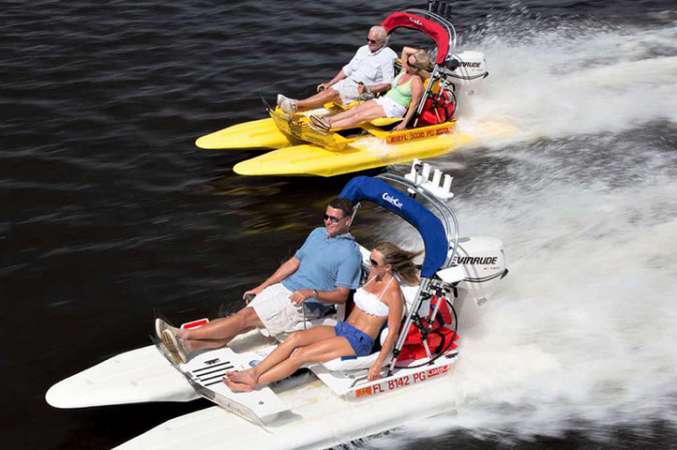
WE PUT FUN BACK IN BOATING!
After 34 years the new models are the best fun machines produced yet! Loaded with amenities the new CraigCat E2 Elite features a premium JBL high definition sound system with USB and Bluetooth connectivity, Deluxe bucket seats, full-width composite storage compartment, convertible bimini top, ion docking, NAV, position, and courtesy deck lights. Big performance within our Compact Boats and easy to use package!
Our (DSTS) Dynamic Sport Tuned Suspension system, and (CHD) Calibrated Hull Design to give you the smoothest ride and high performance fun that no one else can duplicate. Our (ASC) Automatic Stability Control gives the driver and passenger confidence in almost any conditions.Whether it is the fresh or saltwater, for a small fishing boat, or sightseeing CRAIGCAT® HAS THE RIGHT MODEL FOR YOU!
Protected by Patents and Copyrights: 10,144,487 & 842-798 Other patents applied for. Prices and specifications are subject to change without notice.

What Is A Catamaran Sailboat? (And What It Looks Like)

Last Updated by
Daniel Wade
August 30, 2022
Catamarans are increasingly popular for sailing and commercial use, but what sets them apart from monohulls and other multihulls?
A catamaran is a twin-hull boat with two equally-sized hulls placed side by side. They’re powered by engines, sails, or both—and they’re known for efficiency and speed. Catamarans are the most common kind of multihull boat.
In this article, we’ll go over the characteristics of catamarans and how to differentiate them from other types of boats. Additionally, we’ll cover the advantages and disadvantages of catamarans and compare them to trimarans and monohulls. We’ll also go over the most common types of catamarans and their uses.
We sourced the information in this article from marine design guides, boat identification resources, and the online boating community.
Table of contents
How to Spot a Catamaran
Spotting a catamaran is easy. Simply look at the hulls and count them. Catamarans have two hulls side by side and a relatively large gap between them where you can see light on the other end. Catamarans are distinct from trimarans, which have an additional hull between the two outer hulls.
How do Catamarans Work?
The principle behind the catamaran is simple. You can think of catamarans like cars and monohulls like motorcycles. Catamarans distribute their weight between hulls on either side, whereas monohulls utilize only one hull.
Evidently, cars are much more difficult to tip over and can hold much more weight. Additionally, cars are wider, as they have much more contact with the road. Catamarans work in a similar way, as they have a wide stance and contact with the surface on both sides.
Obviously, that isn’t the most precise comparison. But the basic principle is the same, and catamarans have a few notable benefits over monohulls.
Catamaran Vs Monohull
Catamarans are easy to distinguish from monohulls. A monohull is just a regular old boat with a single hull. The vast majority of boats and ships are monohulls. Catamarans have two hulls, which are usually sleek and narrow.
Here are some comparisons of catamarans and monohulls, along with the advantages twin-hull designs have over most single hull types.
Benefits of Catamarans
Catamarans have numerous benefits. The first is speed. Catamarans produce less drag than monohulls and thus can achieve excessive speeds both under sail and power. They don’t need to plane like monohulls to achieve these high speeds, and they use less fuel.
Catamarans are also much more stable than monohulls. They have a wide stance and shallow draft, and many waves and swells can travel between the hulls instead of below them. This effectively reduces an entire axis of movement and prevents catamarans from rolling excessively.
Drawbacks of Catamarans
Catamarans aren’t advantageous in every way, or else we wouldn’t bother building monohulls. The disadvantages of catamarans limit their use to niche commercial applications and high-end yachts. But what are the drawbacks of a twin-hull design?
Sailing catamarans don’t follow many of the traditional boat handling rules and characteristics that sailors pass down for generations. Some, such as hull speed limitations, are good to do away with—while others, such as responsiveness, are not.
Catamarans aren’t as quick to the helm or responsive as monohulls. There are some exceptions to this rule, but for the most part, you’ll get a lot more feedback from a single-hull vessel. Additionally, the large section of deck between the hulls of a catamaran is prone to pounding in rough seas, which is loud and uncomfortable.
Catamarans can sometimes be twice the width of an equivalent monohull sailboat, which can increase mooring fees and limit docking options.
The final major drawback of catamarans is a consequence of their stability. Traditional full-keel monohull sailboats have a very low center of gravity, which makes them roll in heavy seas but ensures a recovery.
Catamarans have a higher center of gravity, and they can’t right themselves after a knockdown. And though catamarans are less likely to roll, a severe list on a multihull is a much more serious concern than on a ballasted monohull.
Catamaran Vs Trimaran
Catamarans and trimarans are often lumped together, but they have very different design and performance specifications. Trimarans have three hulls, whereas catamarans have two.
Trimarans look a lot like catamarans from the side, but a quick glance at the bow or stern can set them apart. Trimarans are faster than catamarans, as they distribute their weight across three hulls instead of two. This helps them stay centered and reduces interference from pitching and rolling.
Catamarans are fast, but they lose out to trimarans when going head to head. However, catamarans are much less expensive to build and maintain and often have roomier cabins due to their larger hulls.
Types of Catamarans
There are numerous types of catamarans, and their uses vary widely. The catamaran is one of the oldest and most useful hull types, and some variants have been used for thousands of years. Here are the most common kinds of catamaran boats and their uses.
Sailing Catamaran
Sailing catamarans are probably what you think of when you hear the name. Sailing catamarans are sailboats with two identical hulls connected by a center deck. The largest sailing catamarans are spacious and stable vessels that are capable of serious offshore sailing.
Sailing catamarans have a number of notable advantages over monohulls. Monohulls, which are traditional sailboats with a single hull, are limited by a simple concept called hull speed. As the bow and stern wave of a monohull intersect, they cause drag which limits the top speed of the boat.
Catamarans are not bound by hull speed limitations, as they have two hulls. Catamarans can go twice or even three times as fast as similar monohulls and achieve excellent travel times.
Catamarans are also more stable than monohulls, as their wide stance and shallow draft reduce the effect of rough water. They don’t heel, as the force of the wind is counteracted by the double hulls. Additionally, modern sailing catamarans can ‘wave pierce’ by cutting through swells instead of riding over them.
Sailing catamarans come in many shapes and sizes. Small sailing catamarans, such as those used in races and regattas, are known for their speed and relative stability compared to light racing monohulls. Sometimes, they feature a smaller second hull for stability—these are called outriggers.
Sailing catamarans have spacious interiors thanks to the large cockpit between the hulls. This cockpit usually contains cooking and eating spaces, a place to sit, and a hallway between the hulls. The hulls usually contain living quarters and often mirror each other.
Power Catamarans
Power catamarans have an even greater variety than sailing catamarans. These vessels are used for everything from party platforms to ferries and patrol boats.
Power catamarans are a recent development, as engineers and marine architects now realize they have numerous hydrodynamic advantages over other hull types.
Catamarans are much more efficient than other hull types, as they have less drag relative to their size. Additionally, you can build a much larger catamaran with less material. This makes them popular for car and rail ferries, as builders can construct a very wide vessel with two small hulls rather than a narrower vessel with a large single hull.
Military and Commercial Catamarans
Even the military has found a use for the catamaran hull shape. The Spearhead class EPF is an expeditionary fast transport vessel designed for carrying capacity and speed. It has two sharp hulls and a huge cargo capacity.
The Spearhead class EPF is 337 feet long, which is about the same length as a WW2 escort destroyer. Yet despite having a similar length and displacement, these catamarans can travel more than twice as fast—43 knots, or nearly 50 miles per hour. Their great speed is a direct consequence of their catamaran hull type.
Power catamarans are also used as patrol and utility boats on a much smaller scale, with either outboard or inboard motors. The State of Texas uses catamarans to patrol shallow rivers and lakes. Texas Game Wardens utilize state-of-the-art aluminum catamaran patrol boats, which are fast enough to outrun most fishing boats.
There’s another form of power catamaran that you may not have considered. Pontoon boats are technically catamarans, and they’re enormously popular on lakes and rivers throughout the country. Pontoon boats aren’t known for speed, but they’re a great platform for a fun and comfortable outing.
Catamaran Houseboats
The final common type of power catamaran is the two-hulled houseboat. Houseboats don’t always use the catamaran hull type, but it’s common enough that most major manufacturers offer it as an option.
Catamaran houseboats have a few notable advantages over monohull designs. For one, they’re easier to build—especially when pontoons are chosen. Additionally, they’re better suited for navigating shallow water. These vessels can support more weight across their two hulls, offer increased stability, and they’re also efficient.
Why Aren’t Catamarans More Common?
With all the advantages listed in this article to consider, it may seem strange that the use of catamarans is still somewhat limited. At the end of the day, it comes down to economics—as monohull boats and ships are simply cheaper to build.
Additionally, catamarans have some distinct limitations. Monohulls have lots of storage space in their hulls and can carry thousands of tons of cargo safely in all weather conditions. Catamarans lack this space and low center of gravity, so they’re not ideal for transporting cargo past a certain point.
Additionally, monohulls work, and many people are reluctant to experiment with new designs when old designs work just fine. This rule applies to both large and small boats.
A large monohull sailboat can be constructed at low cost from stock plans and reliably sail almost anywhere. Very little complex structural engineering is involved, and looser tolerances reduce cost and maintenance requirements.
Related Articles
I've personally had thousands of questions about sailing and sailboats over the years. As I learn and experience sailing, and the community, I share the answers that work and make sense to me, here on Life of Sailing.
by this author
Learn About Sailboats
Most Recent

What Does "Sailing By The Lee" Mean?
October 3, 2023

The Best Sailing Schools And Programs: Reviews & Ratings
September 26, 2023
Important Legal Info
Lifeofsailing.com is a participant in the Amazon Services LLC Associates Program, an affiliate advertising program designed to provide a means for sites to earn advertising fees by advertising and linking to Amazon. This site also participates in other affiliate programs and is compensated for referring traffic and business to these companies.
Similar Posts

Affordable Sailboats You Can Build at Home
September 13, 2023

Best Small Sailboat Ornaments
September 12, 2023

Discover the Magic of Hydrofoil Sailboats
December 11, 2023
Popular Posts

Best Liveaboard Catamaran Sailboats
December 28, 2023

Can a Novice Sail Around the World?
Elizabeth O'Malley
June 15, 2022

4 Best Electric Outboard Motors

How Long Did It Take The Vikings To Sail To England?

10 Best Sailboat Brands (And Why)
December 20, 2023

7 Best Places To Liveaboard A Sailboat
Get the best sailing content.
Top Rated Posts
Lifeofsailing.com is a participant in the Amazon Services LLC Associates Program, an affiliate advertising program designed to provide a means for sites to earn advertising fees by advertising and linking to Amazon. This site also participates in other affiliate programs and is compensated for referring traffic and business to these companies. (866) 342-SAIL
© 2024 Life of Sailing Email: [email protected] Address: 11816 Inwood Rd #3024 Dallas, TX 75244 Disclaimer Privacy Policy

The Ultimate Guide to Choosing Between a Sailboat or Catamaran for Your Sailing Adventures
C hoosing between a sailboat and a catamaran for your sailing adventures is a significant decision that depends on various factors, including your sailing preferences, experience level, budget, and intended use. Here's an ultimate guide to help you make an informed decision:
1. Sailing Experience:
- Sailboats: Typically require more skill and experience to handle, especially in adverse weather conditions. Ideal for sailors who enjoy the traditional feel of sailing and are willing to invest time in learning and mastering the art.
- Catamarans: Easier to handle, making them suitable for beginners. The dual-hull design provides stability, reducing the learning curve for those new to sailing.
2. Space and Comfort:
- Sailboats: Generally have a narrower beam and less living space. However, some sailboats may offer comfortable cabins and amenities.
- Catamarans: Wider beam creates more living space. Catamarans often have multiple cabins, spacious saloons, and expansive deck areas, providing a more comfortable living experience.
3. Stability:
- Sailboats: Monohulls can heel (lean) while sailing, which some sailors enjoy for the thrill but can be discomforting for others.
- Catamarans: Greater stability due to the dual hulls, providing a more level sailing experience. Reduced heeling makes catamarans suitable for those prone to seasickness.
4. Performance:
- Sailboats: Known for their upwind performance and ability to sail close to the wind. Some sailors appreciate the challenge of optimizing sail trim for efficiency.
- Catamarans: Faster on a reach and downwind due to their wide beam. However, they may not point as high into the wind as monohulls.
- Sailboats: Typically have a deeper draft, limiting access to shallow anchorages and requiring deeper marina berths.
- Catamarans: Shallow draft allows access to shallower waters and secluded anchorages, providing more flexibility in cruising destinations.
- Sailboats: Generally more affordable upfront, with a wide range of options available to fit different budgets.
- Catamarans: Often more expensive upfront due to their size and design. However, maintenance costs may be comparable or even lower in some cases.
7. Mooring and Docking:
- Sailboats: Easier to find slips and moorings in marinas designed for monohulls.
- Catamarans: Require wider slips and may have limited availability in certain marinas, especially in crowded anchorages.
8. Intended Use:
- Sailboats: Ideal for traditional sailors who enjoy the art of sailing, racing enthusiasts, or those on a tighter budget.
- Catamarans: Suited for those prioritizing comfort, stability, and spacious living areas, especially for long-term cruising and chartering.
9. Resale Value:
- Sailboats: Generally have a more established resale market, with a wider range of buyers.
- Catamarans: Growing in popularity, and well-maintained catamarans often retain their value.
10. Personal Preference:
- Consider your personal preferences, the type of sailing you plan to do, and the kind of lifestyle you want aboard your vessel.
In conclusion, both sailboats and catamarans have their advantages and disadvantages. Your decision should be based on your individual preferences, experience level, budget, and intended use. If possible, charter both types of vessels to experience firsthand how they handle and to help make a more informed decision based on your own preferences and needs.
The post The Ultimate Guide to Choosing Between a Sailboat or Catamaran for Your Sailing Adventures appeared first on Things That Make People Go Aww .

Share in social networks
So far, no one has left a review. be the first.

Do you live in the Murmansk region? Join us!
Do you know an interesting route or cool objects that are not yet on the project map? Share interesting facts and objects, as well as leave comments with hints and tips – let's develop the project together!
Wind and weather webcams Ostrovnoy
Webcams at and around ostrovnoy, webcams by distance, webcams on map, nearby spots (within 25 km).
- Svyatyj Nos 15km Weather station Wave forecast
Look at our wind map to find more spots among our 160,000 spots.
Ostrovnoy popularity
Most popular spots in russia.
Have a look at the top kitesurfing, windsurfing, sailing, surfing or fishing spots in Russia
Additional information
Whether you are planning your trip for today or you just want to explore, Windfinder has webcams for spots and locations in Russia and all over the world. Quickly check swell, wind and cloud coverage by examining webcam feeds from around your destination. Webcams at Ostrovnoy are discoverable on a map for further exploration or a convenient list view sorted by distance up to 25 kilometers from this spot.
Severe Weather Warnings

IMAGES
VIDEO
COMMENTS
This technique is hit or miss when sailing. Most fishing boats or fishing charters that use this technique have a sonar fish finder to help them target the fish. Doing it on a sailboat is somewhat of a guessing game, but it has worked for us before. Try and find something with good bottom structure if possible.
We catch fish almost 100% of the time that we put a line in the water. Guaranteed! Our handline is made with a high quality 4mm nylon chord terminated with a swivel. The lure (always a blue cedar plug) has a nylon filament leader which is then attached to the heavy duty swivel. The handline is anchored to the stanchion on the back of the boat ...
Available from 20 to 48 feet, catamarans typically offer a large fishing platform with generous storage and fishing amenities. They are available in a wide variety of deck layouts, including center-consoles, dual-consoles, and even pilothouse and express variants. Cats offer abundant deck space. Courtesy Invincible.
Caymas is a newcomer to the catamaran world, having built only monohulls up to the 2023 model year. Their new 34, however, is an impressive boat which has offshore abilities and will also make an excellent inshore fishing machine. It rides on a set of twin-stepped hulls with 18/22-degree deadrise surfaces at the transom and 50/55-degree entries ...
35SF Catamaran. Our largest boat gives you the size and range for any type of fishing, anywhere you want to go. Customize this with an upper station and a huge coffin box. ... Our commercial strength hulls will provide you a top of the line boating and fishing experience. Our Story. 2102 US-421, Wilmington, NC 28401 ...
Here's what you need to do: Fill out the BVI Form 20a (application) Fill out the credit card authorization. Obtain a copy of your identification - they recommend a scan of your passport. Submit all three items to [email protected] for approval. Additional notes: It costs $45/person (as of Sep-2023)
Offshore runs can total 20 to 50 miles. "The wide 10-foot-6-inch beam of our cats allows plenty of room to move around, and for multiple anglers to cast and fish with minimal to no roll when drifting," he says. In fact, outside the United States, catamarans have been popular for a long time.
Renaissance Prowler is a family company, and that family includes everybody who owns a Prowler. Our hull designs play a part too. We've been pushing the envelope with high-performance offshore catamarans since 1997 — long before their recent surge in popularity with hardcore offshore anglers. Those decades of experience show up in our best ...
Catamarans are the perfect backdrop to a relaxing fishing excursion, with sails in the wind as you reel in 50-pound striped bass. But when the gusts pick up ... Sailing a catamaran upwind and downwind requires a skill set much different from the classic one hulled sailing. To sail a catamaran upwind, maintain high speeds, center the mainsheet ...
Now it's time to do it again with our smallest platform yet. We took the unprecedented performance, versatility and amenities of our model lineup and packaged it in a powerful, agile and nimble new form. Introducing the new Invincible 33' Catamaran. A whole new size of serious. WALKTHROUGH | Invincible 33' Catamaran.
AmeraCat wanted to design a power catamaran that was in between 27′ and 39′, that is why we created the 31′ AmeraCat center console power catamaran. We feel that for the sport fisherman, this is one of the best offshore fishing power catamarans we offer. Great for Charter Boat Captains as well as the everyday fisherman.
Fountaine Pajot, one of the foremost builders of sailing catamarans, unveiled their biggest "Super Catamaran" ever: the Thira 80. The release comes on the tail of an ever-increasing trend in the catamaran market—the bigger-the- better era. With Sunreef, Lagoon, and Gunboat all making boats in the 70 to 80-foot range, these companies ...
August 27, 2020. The market for offshore catamarans has exploded in recent years, and catamaran fishing boats are driving much of the surge in popularity. Newer catamarans are bigger, faster, highly fuel efficient and a near ideal fit for the angler on the west coast of Florida that needs to run 50 to 100 miles to his favorite fishing spot.
Let us introduce you to five power catamarans and five sail multihulls, and then let us get you on the water with one! Here are the ten best catamarans for 2023: World Cat 260 CCX. Four Winns TH36. Leopard 40 PC. Aquila 42 PC. HammerCat 45. Fountaine Pajot Tanna 47. Bali 4.4.
Short Answer. Sailing a catamaran is relatively straightforward. To get started, adjust the sails and rudder to the desired angles. Next, begin to move forward using the power of the wind and the force of the sails. While underway, make sure to constantly adjust the sails and rudder to maintain the desired course.
Gunboat 62. gunboat_catamarans. An original performance catamaran cruiser from the iconic Gunboat manufacturer, the Gunboat 62 has truly cemented its place as one of the best catamaran sailboats to ever grace the oceans. Honestly speaking, this cat-inspired a whole range of other incredible boats including HH66 Catamaran and the Balance 526.
Available from 20 to 48 feet, catamarans typically offer a large fishing platform with generous storage and fishing amenities. They are available in a wide variety of deck layouts, including center-consoles, dual-consoles, and even pilothouse and express variants. Cats offer abundant deck space. Courtesy Invincible.
The ergonomic, side-by-side seating and dual-action controls provide an incredible, one of a kind experience you can only get with a CraigCat®. It's the only power catamaran boat that has the versatility for fishing, day cruising, relaxing or diving … a boat that is as easy to operate and launch as it is on the bank account.
Sailing catamarans are sailboats with two identical hulls connected by a center deck. The largest sailing catamarans are spacious and stable vessels that are capable of serious offshore sailing. ... Texas Game Wardens utilize state-of-the-art aluminum catamaran patrol boats, which are fast enough to outrun most fishing boats. There's another ...
Sailboats: Generally have a narrower beam and less living space. However, some sailboats may offer comfortable cabins and amenities. Catamarans: Wider beam creates more living space. Catamarans ...
The organization of amateur fishing of Kamchatka crab in the Barents Sea on the site of Svyatonossky Bay 2 is carried out by LLC "Murmanskturist". Place of issue of vouchers: Сlosed administrative-territorial entity Ostrovnoy, Sovetskaya str, 2. For entry into the city of Ostrovnoy you need to issue a pass.
Detailed wind, waves & weather forecast for Ostrovnoy / Murmansk Oblast, Russia for kitesurfing, windsurfing, sailing, fishing & hiking.
Minor fishing times From 7:39am to 8:39am Moonrise From 3:16pm to 4:16pm Moonset. Click here to see Ostrovnoy fishing times for the week. Current weather in Ostrovnoy. Weather . Moderate or heavy snow showers. Cloud cover 100%. Temperature -3°C. Min -4°C/Max -2°C Wind . 2 km/h. Wind gust 3 km/h.
This is the webcam overview page for Ostrovnoy in Murmansk Oblast, Russia. Windfinder specializes in wind, waves, tides and weather reports & forecasts for wind related sports like kitesurfing, windsurfing, surfing, sailing or paragliding. Webcams You can view all wind and weather webcams as well as live cams nearby Ostrovnoy on the above map.